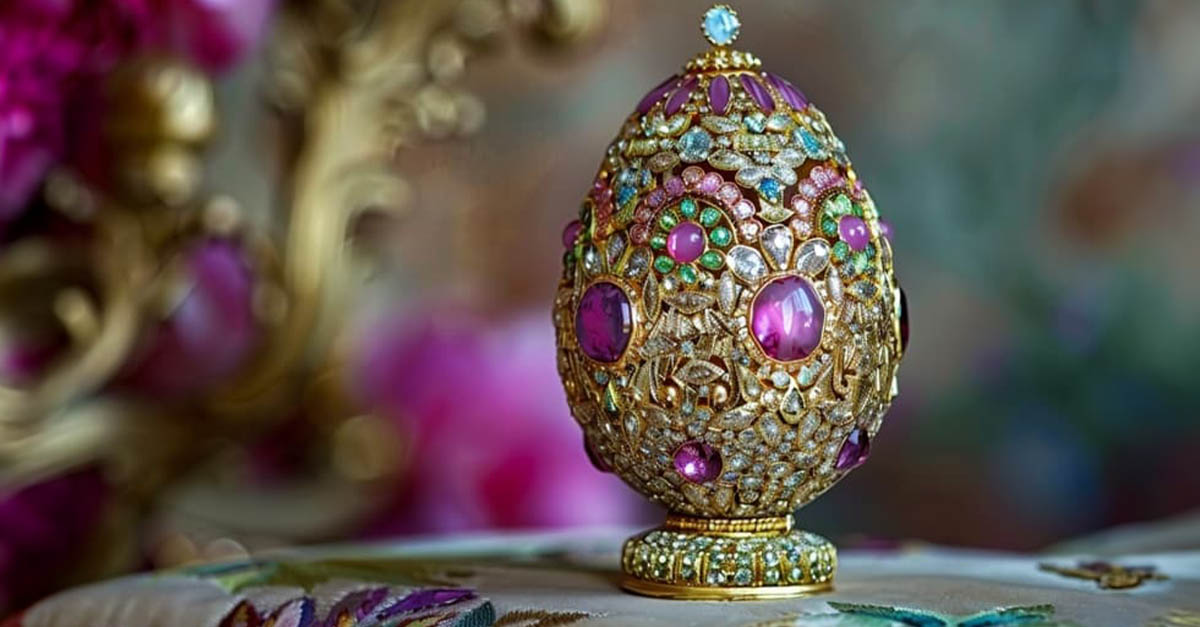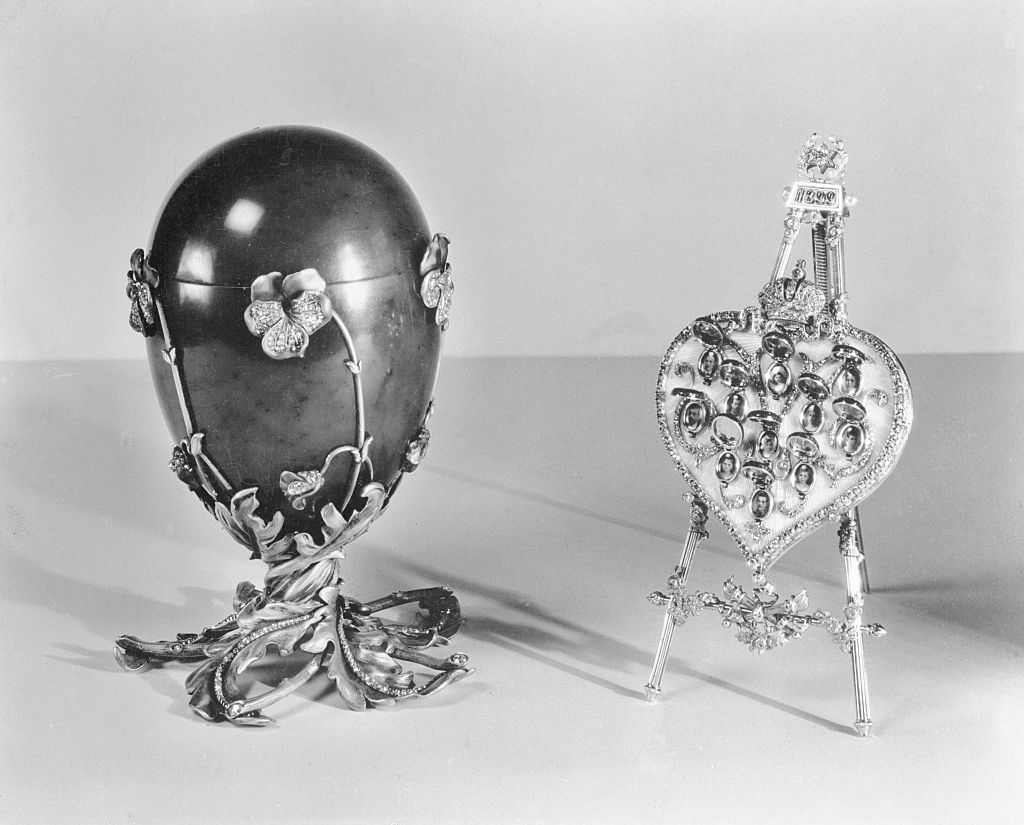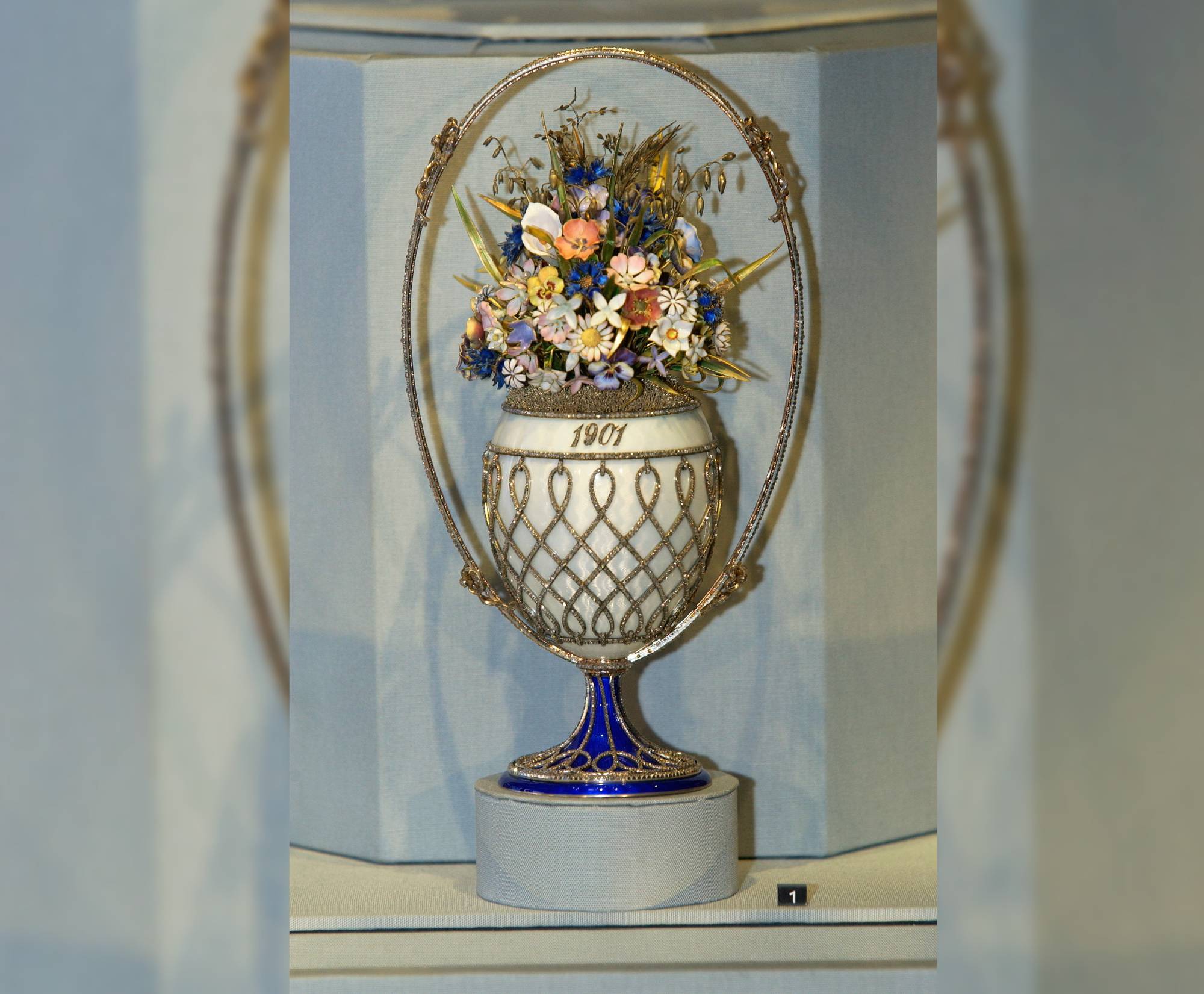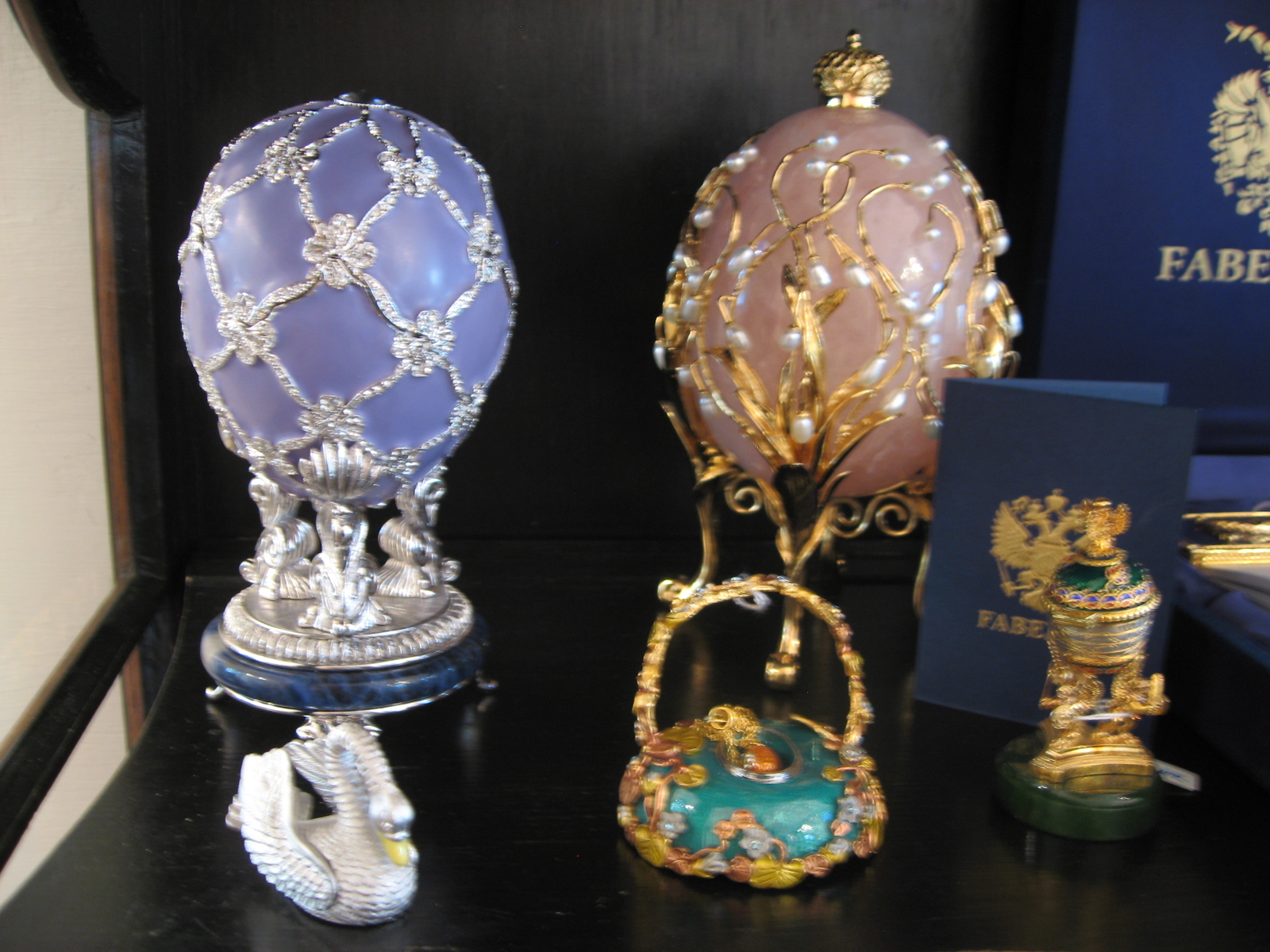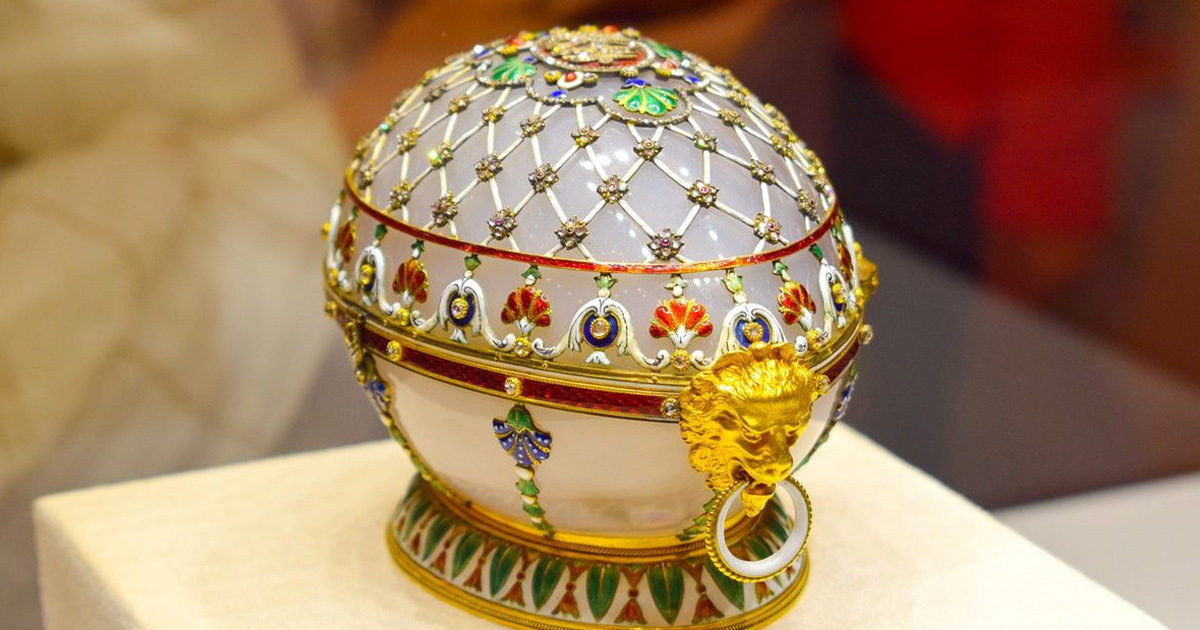The Most Famous Eggs In The World
From 1885 to 1917, Emperors Alexander III and Nicholas II of Russia gave their wives and mothers the most extraordinary gifts: the legendary Fabergé Eggs. These intricate jeweled creations are among the most valuable and elaborate treasures in the world. Here are the stories behind some of the eggs.
Hen (1885)
The first of the eggs, the First Hen, established the tradition of containing intricate surprises inside. The egg opens to reveal a golden yolk which itself contains a jeweled hen with ruby eyes. The hen also opens, revealing tiny versions of the Russian imperial crown and a ruby pendant. The final two surprises are, unfortunately, lost to history.
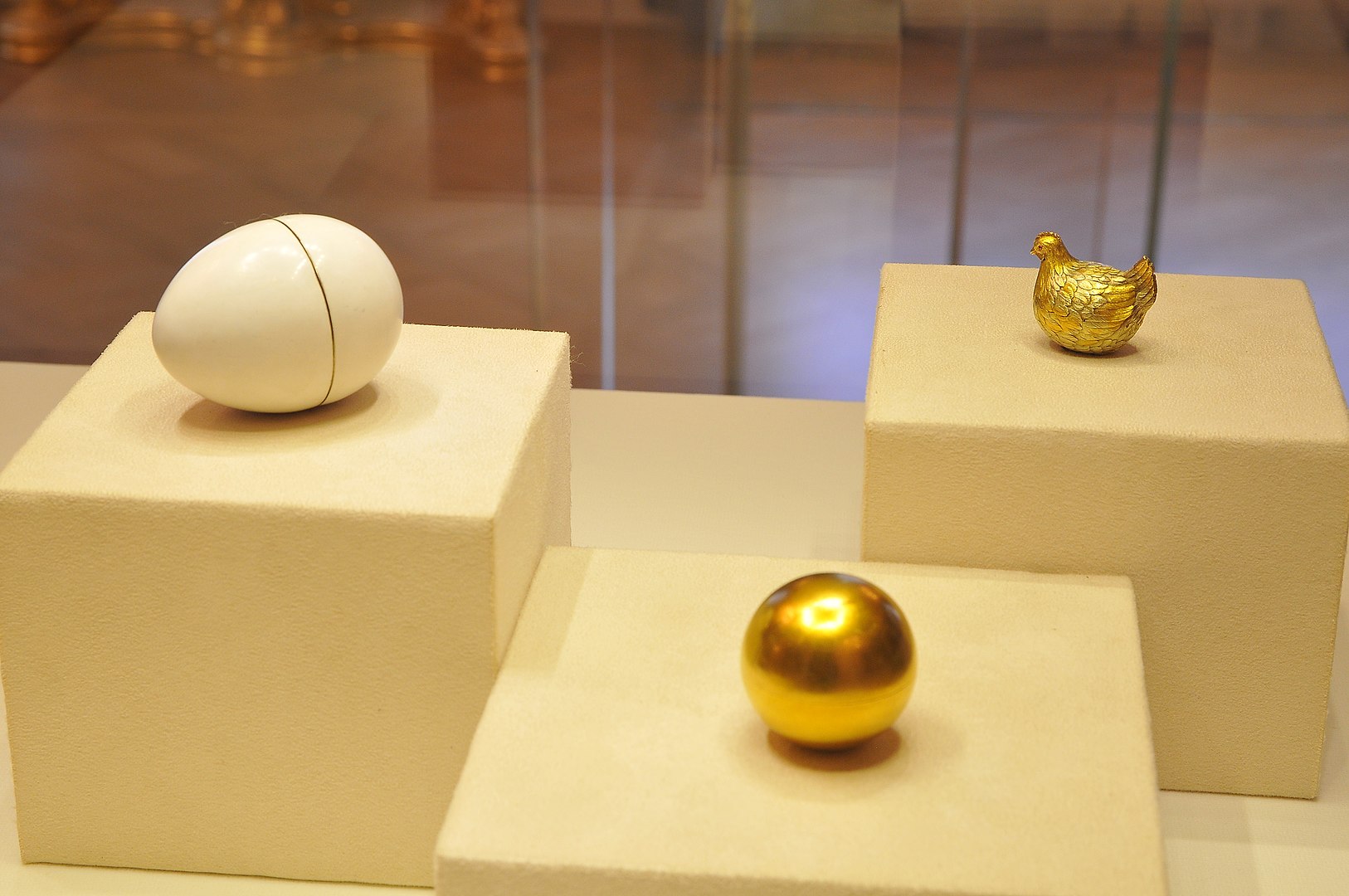 Михаил Овчинников, CC BY-SA 4.0, Wikimedia Commons
Михаил Овчинников, CC BY-SA 4.0, Wikimedia Commons
Third Imperial (1887)
Presented to Maria Feodorovna on Easter 1887, this egg sits on a golden stand and contains a 14K gold Vacheron Constantin lady’s watch. The Third Imperial was thought lost for many years, but was rediscovered in 2012 and now sits in a private collection.
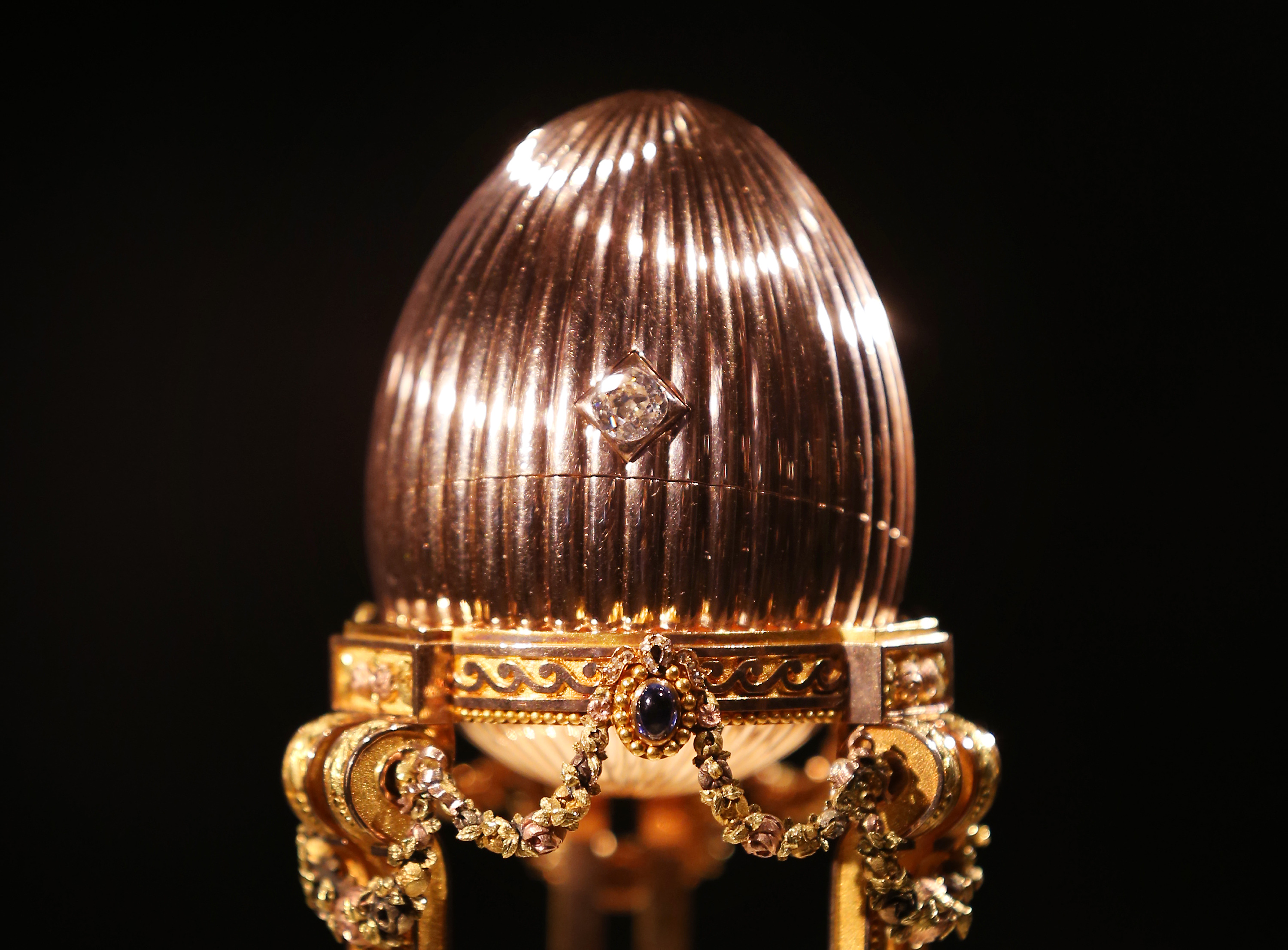 Peter Macdiarmid, Getty Images
Peter Macdiarmid, Getty Images
Danish Palaces (1890)
This egg is held at the MOMA in New York as part of the Matilda Geddings Gray Foundation. A pink-mauve egg decorated with emeralds, the Danish Palaces contains a 10-panel screen decorated with 10 watercolors by Konstantin Krijitski. The paintings depict locations and items of importance to the Russian royal family.
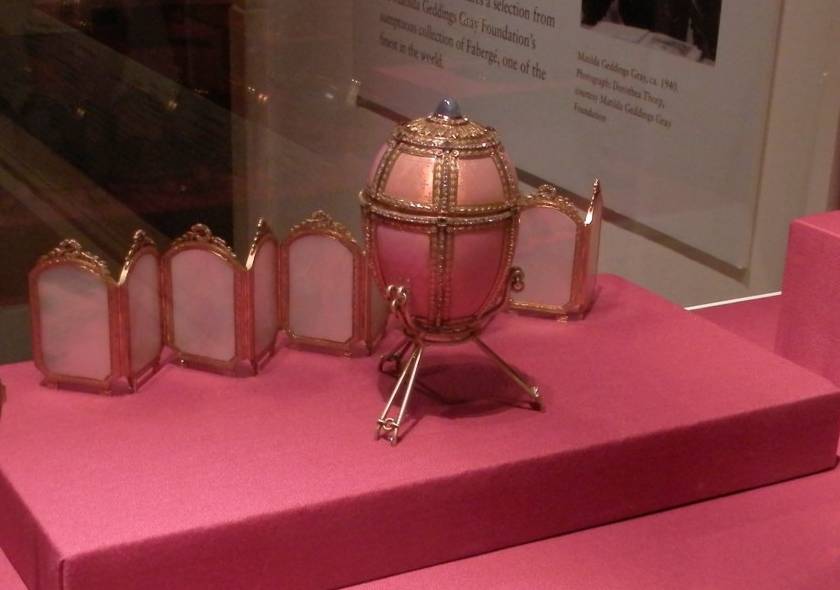 elrohir ancalin, CC BY-SA 2.0, Wikimedia Commons
elrohir ancalin, CC BY-SA 2.0, Wikimedia Commons

History's most fascinating stories and darkest secrets, delivered to your inbox daily.
Memory Of Azov (1891)
Carved from a solid piece of bloodstone, the Memory of Azov egg contains a small replica of the ship for which it is named. This was the boat that future Emperor Nicholas II voyaged on to the Far East in an attempt to broaden the perspective needed by a future ruler of Russia. His mother, the Tsarina, did not like this egg as much as the others.
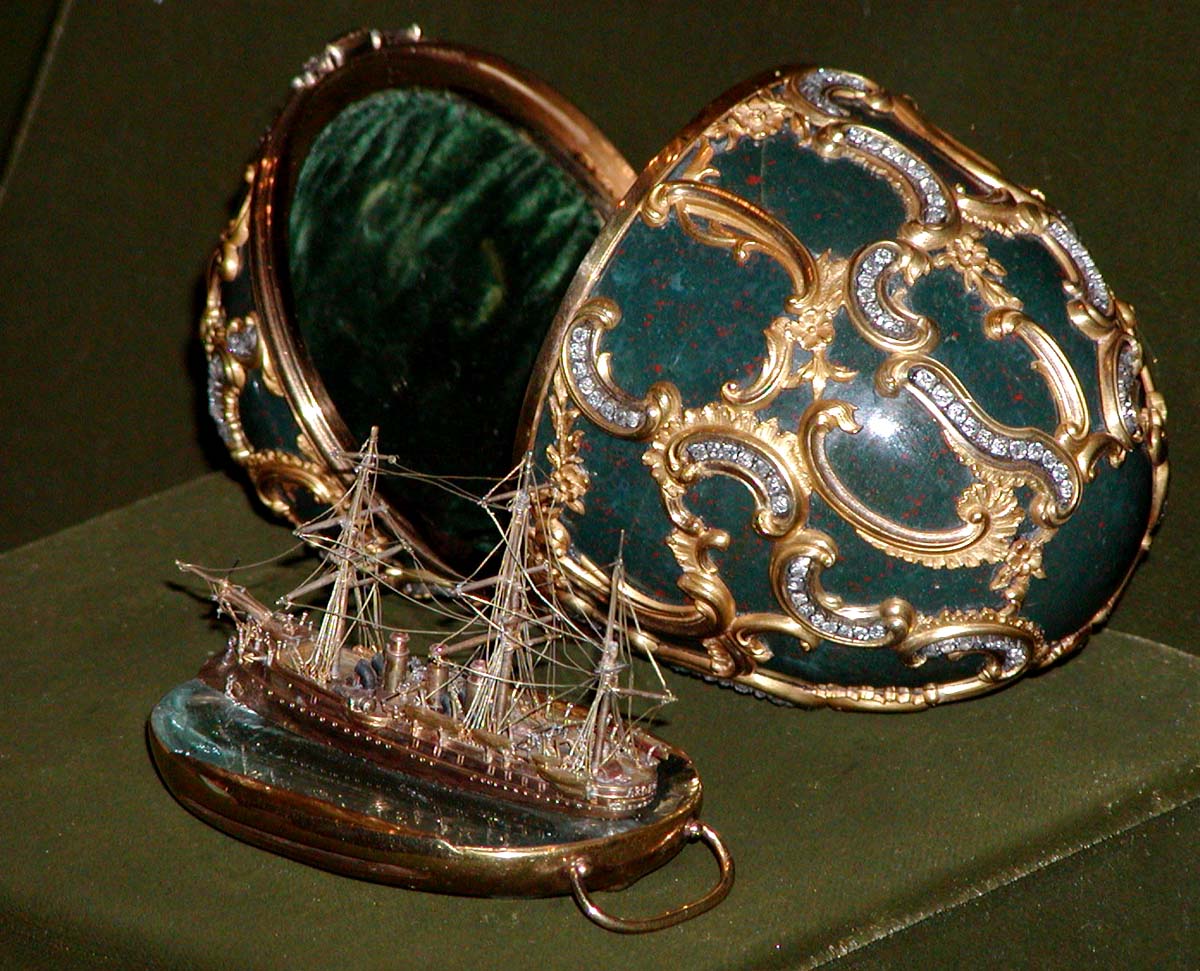 Stan Shebs, CC BY-SA 3.0, Wikimedia Commons
Stan Shebs, CC BY-SA 3.0, Wikimedia Commons
Diamond Trellis (1892)
The Diamond Trellis egg is owned by Dorothy McFerrin, whose late husband had one of the largest Fabergé art collections in the United States. The surprise, a wind-up jeweled elephant, was thought lost for many years until it was rediscovered in the collection of the British royal family. Both egg and elephant were reunited for the first time in a display in 2017.
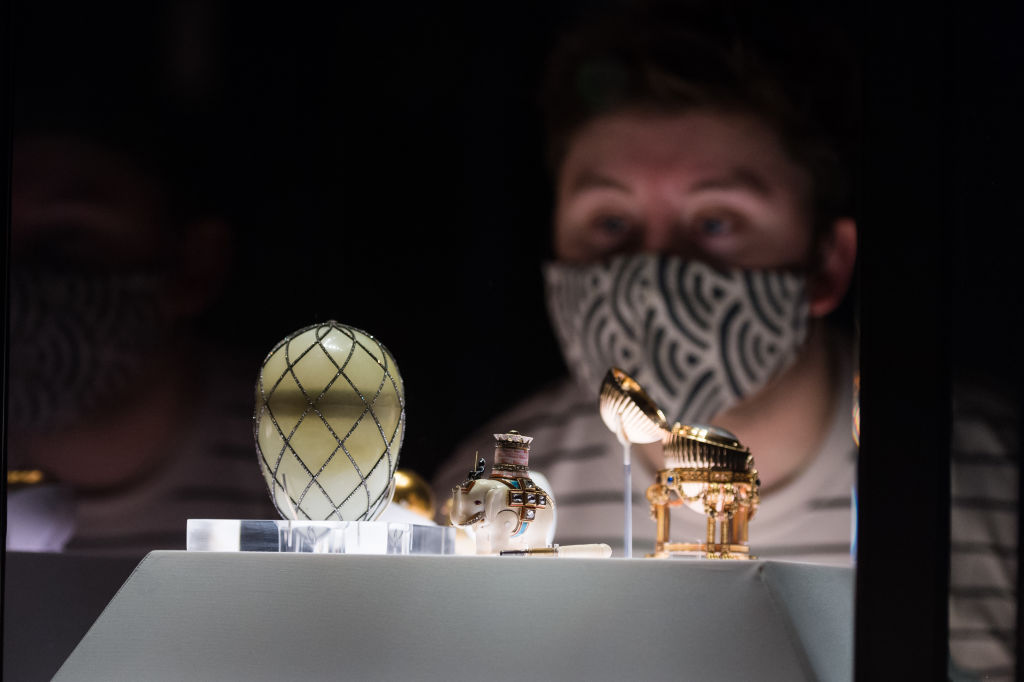 Wiktor Szymanowicz, Getty Images
Wiktor Szymanowicz, Getty Images
Caucasus (1893)
This egg is a tribute to Grand Duke George, a member of the family who spent a great deal of time in the Caucasus after being diagnosed with tuberculosis. The Caucasus egg’s surprise is four miniature paintings concealed behind pearl-bordered doors on the egg. It is also decorated with platinum, diamonds, ivory, and silver.
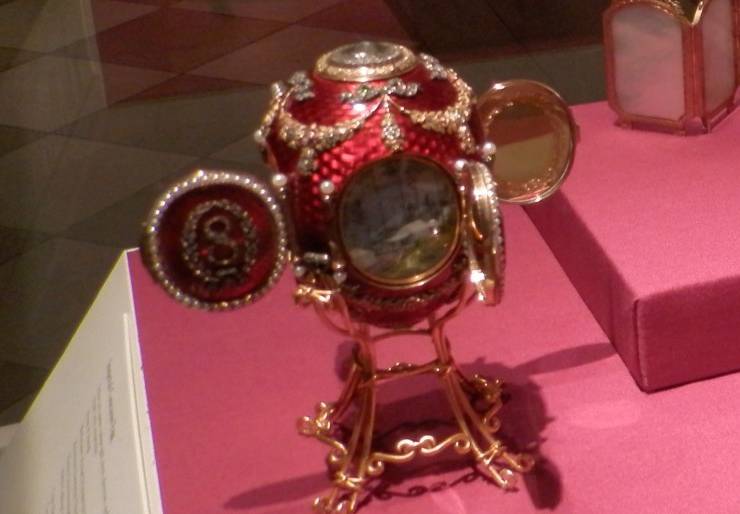 elrohir ancalin, CC BY-SA 2.0, Wikimedia Commons
elrohir ancalin, CC BY-SA 2.0, Wikimedia Commons
Renaissance (1894)
The surprise inside the Renaissance egg is long lost, though some theories abound. One is that, due to a line on the invoice, the surprise had something to do with pearls. Another is that a Fabergé known as the Resurrection egg was designed to fit inside Renaissance. The two have similar design features, and Resurrection features pearls in its decoration.
 Михаил Овчинников, CC BY-SA 4.0, Wikimedia Commons
Михаил Овчинников, CC BY-SA 4.0, Wikimedia Commons
Rosebud (1895)
This was the first egg presented by Nicholas II to his wife Alexandra Feodorovna after the death of his father. The surprises of the Rosebud were thought lost until 2021 when it was theorized that they were in fact concealed inside a “fauxbergé” (keep reading!) called the Lapis Lazuli owned by the Cleveland Museum of Art.
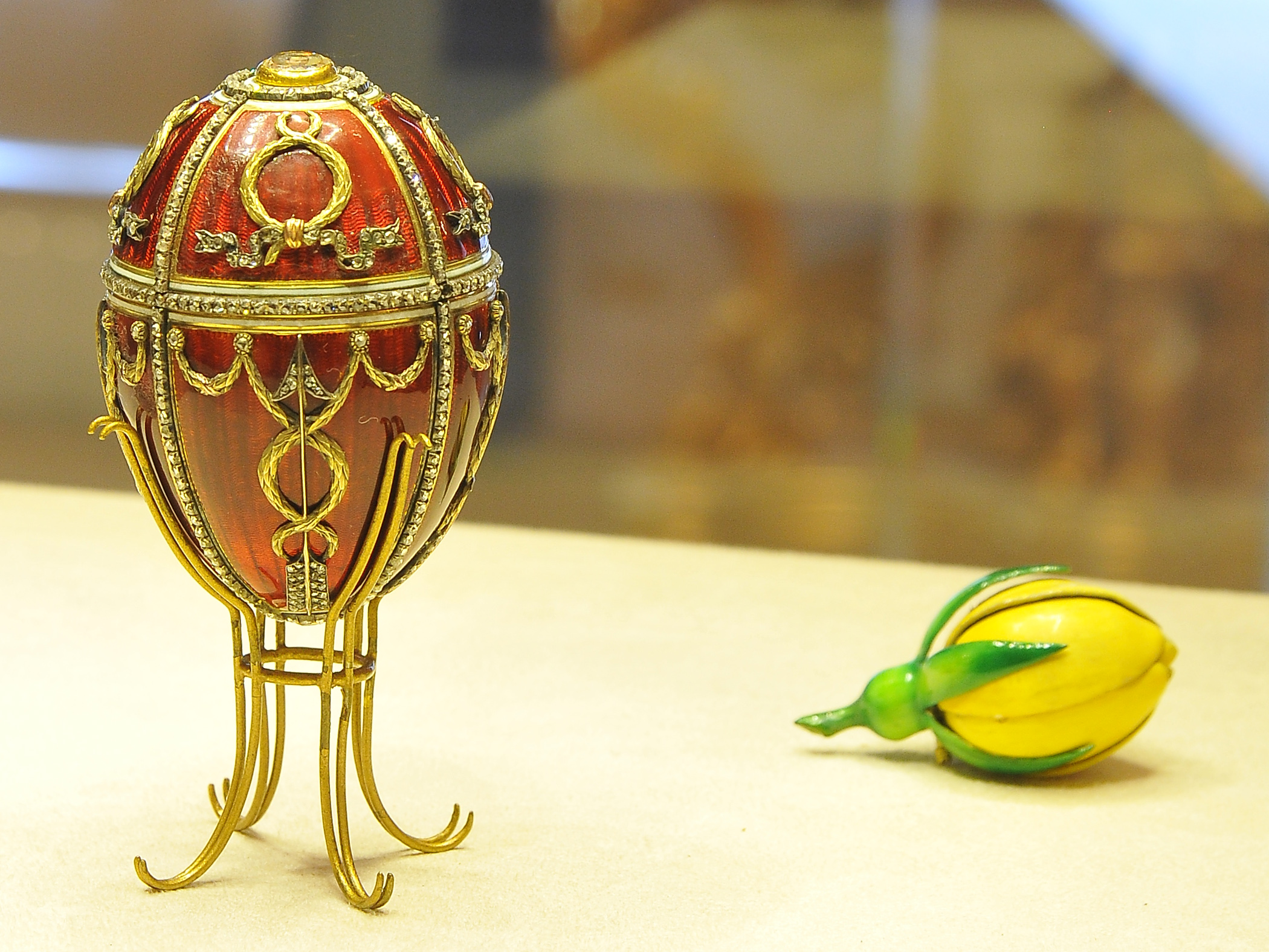 Михаил Овчинников, CC BY-SA 4.0, Wikimedia Commons
Михаил Овчинников, CC BY-SA 4.0, Wikimedia Commons
Rock Crystal (1896)
When the large emerald on top of the Rock Crystal egg is pressed, the surprise inside—12 miniature paintings—begins to revolve for the viewer. The egg is made from rock crystal, while the paintings depict events and locations important to the Emperor and Empress, who had married only two years prior.
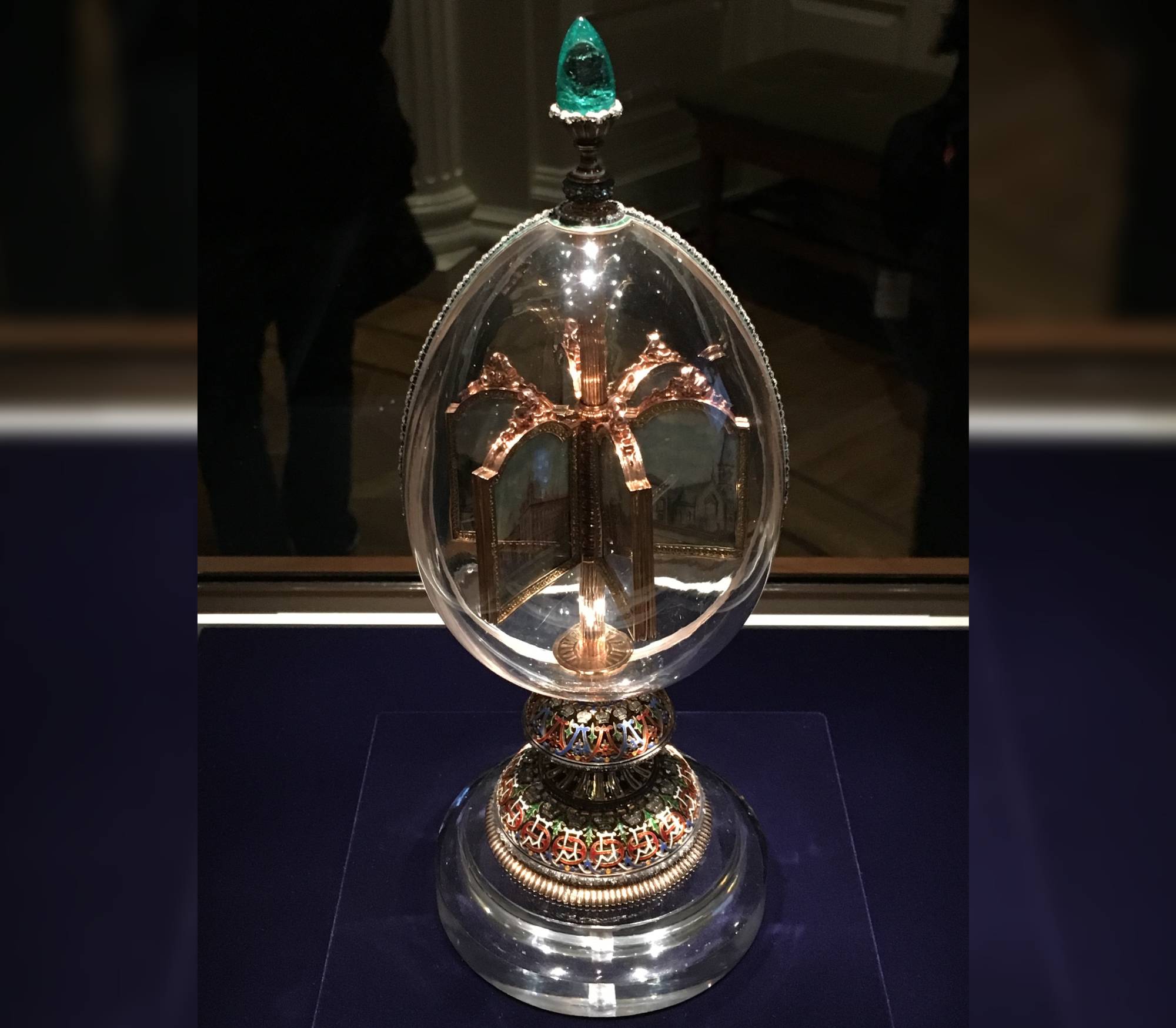 Hemant Bedekar, CC BY 2.0, Wikimedia Commons
Hemant Bedekar, CC BY 2.0, Wikimedia Commons

History's most fascinating stories and darkest secrets, delivered to your inbox daily.
Twelve Monograms (1896)
This egg is decorated with Cyrillic characters commemorating the marriage of Alexander III and Maria Fedorovna. It is one of a number of Fabergé designed to remember the previous Emperor. The surprise in Twelve Monograms, thought to be six miniatures of Alexander III, is still missing.
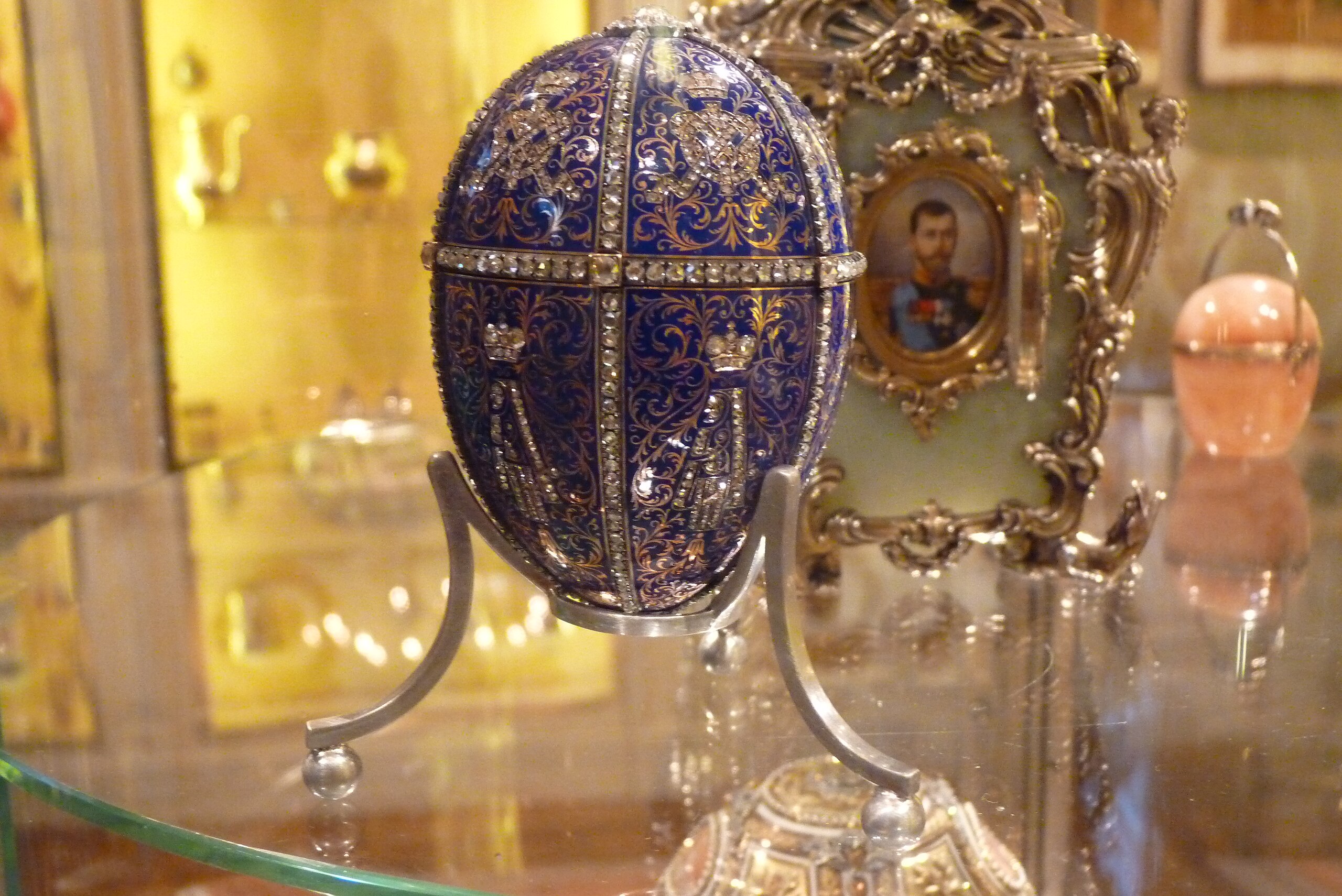 ctj71081, CC BY-SA 2.0, Wikimedia Commons
ctj71081, CC BY-SA 2.0, Wikimedia Commons
Imperial Coronation (1897)
Designed to commemorate the coronation of Nicholas II and his Empress, the outer shell of the Imperial Coronation was designed to resemble the gown worn by Tsarina Alexandra at the event. The surprise inside is a tiny replica of the carriage in which she arrived at Uspensky Cathedral to be crowned. The coronation was an important moment of national pride in Russia.
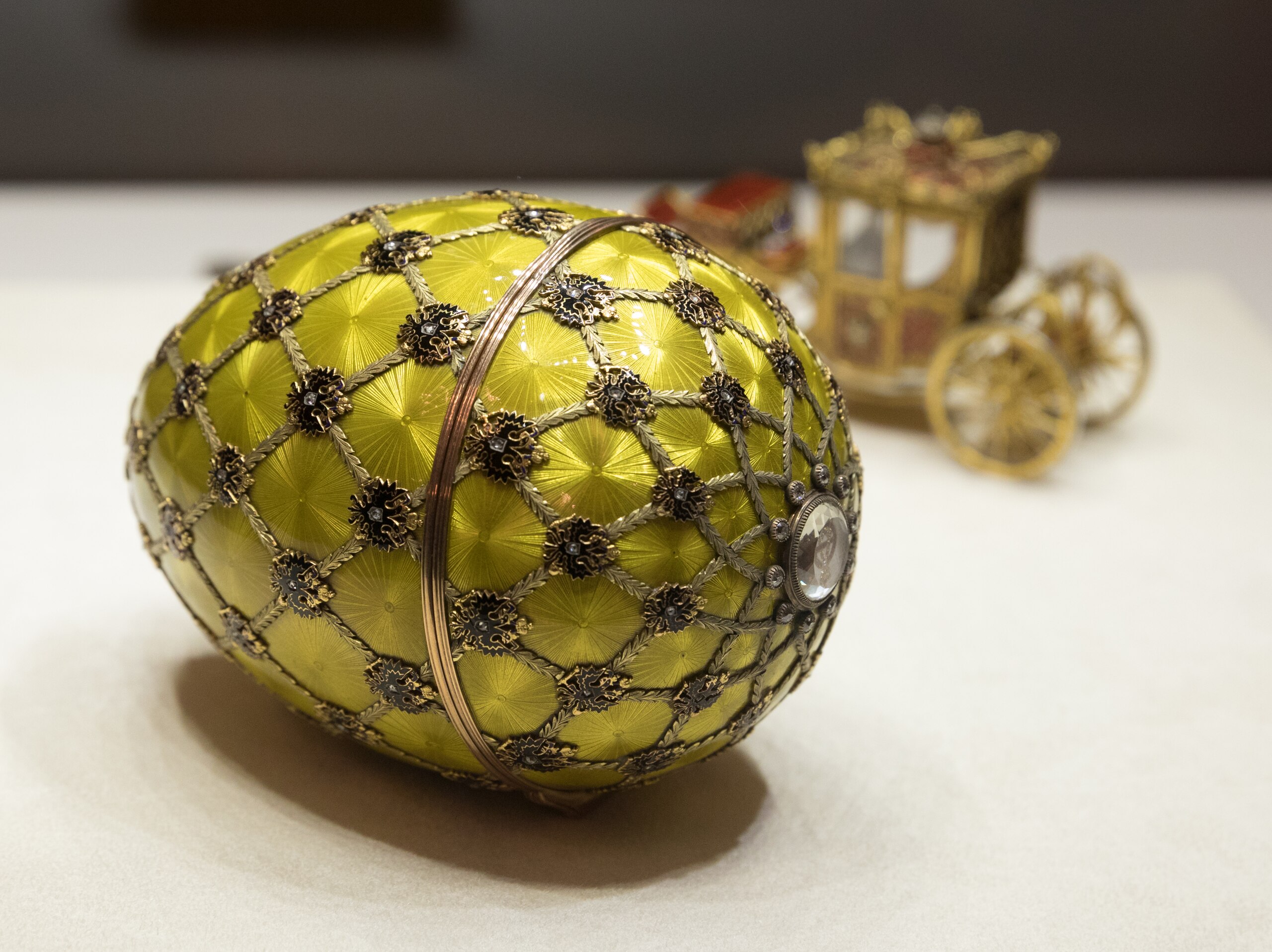 Ninara, CC BY 2.0, Wikimedia Commons
Ninara, CC BY 2.0, Wikimedia Commons
Lilies Of The Valley (1898)
This egg is covered in gold-stemmed lilies, with flowers set with rubies, pearls, and diamonds. A pearl button at the top, when twisted, reveals three portraits that rise out of the Lilies of the Valley egg. The portraits show Tsar Nicholas II and his two oldest daughters. The portraits were painted by the artist Johannes Zehngraf.
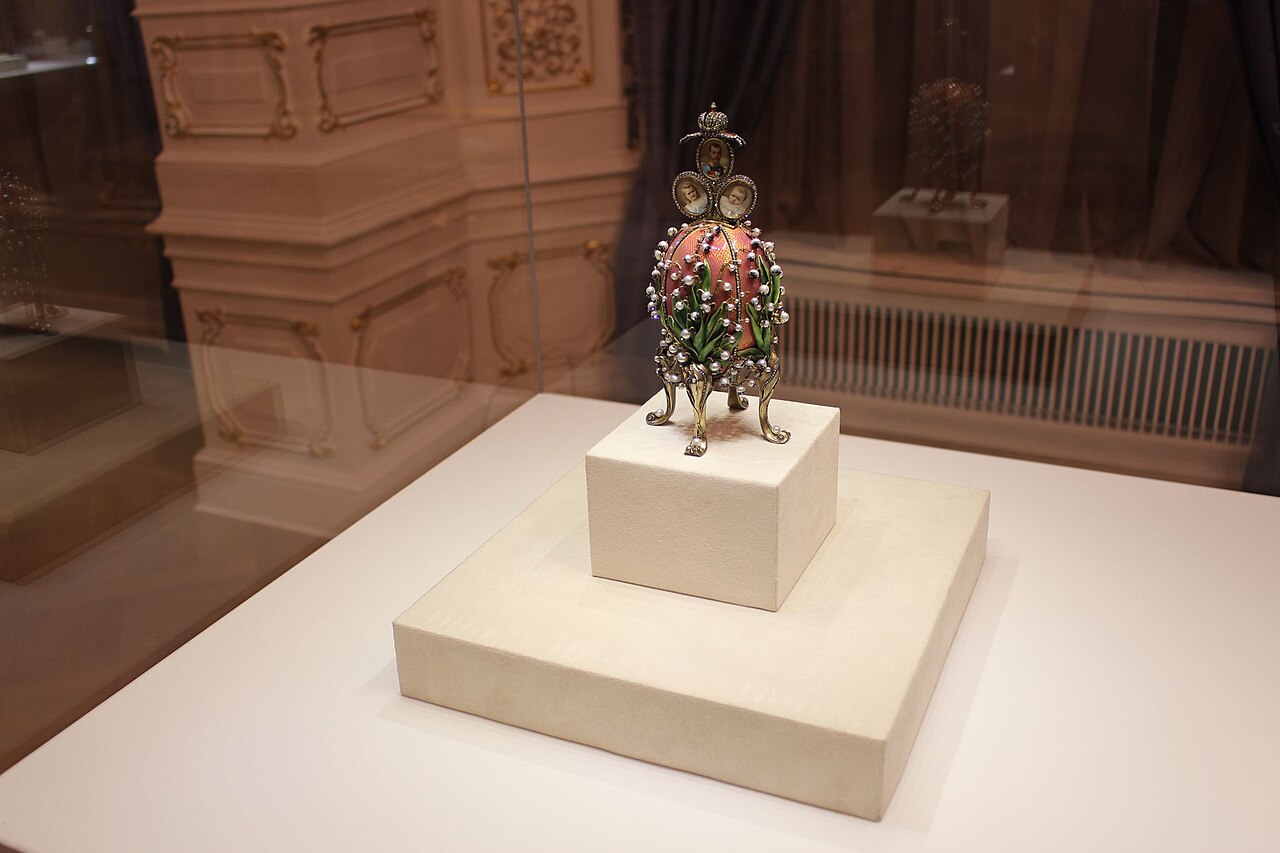 Guy Fawkes, CC BY-SA 2.0, Wikimedia Commons
Guy Fawkes, CC BY-SA 2.0, Wikimedia Commons
Pelican (1898)
One of the few Fabergé eggs to not be enameled, the Pelican is made primarily of shining red gold. An enamel pelican sits on top of it. This was a gift to the Dowager Empress, and the surprise inside was a series of miniature pictures of charitable institutions to which she devoted her time.
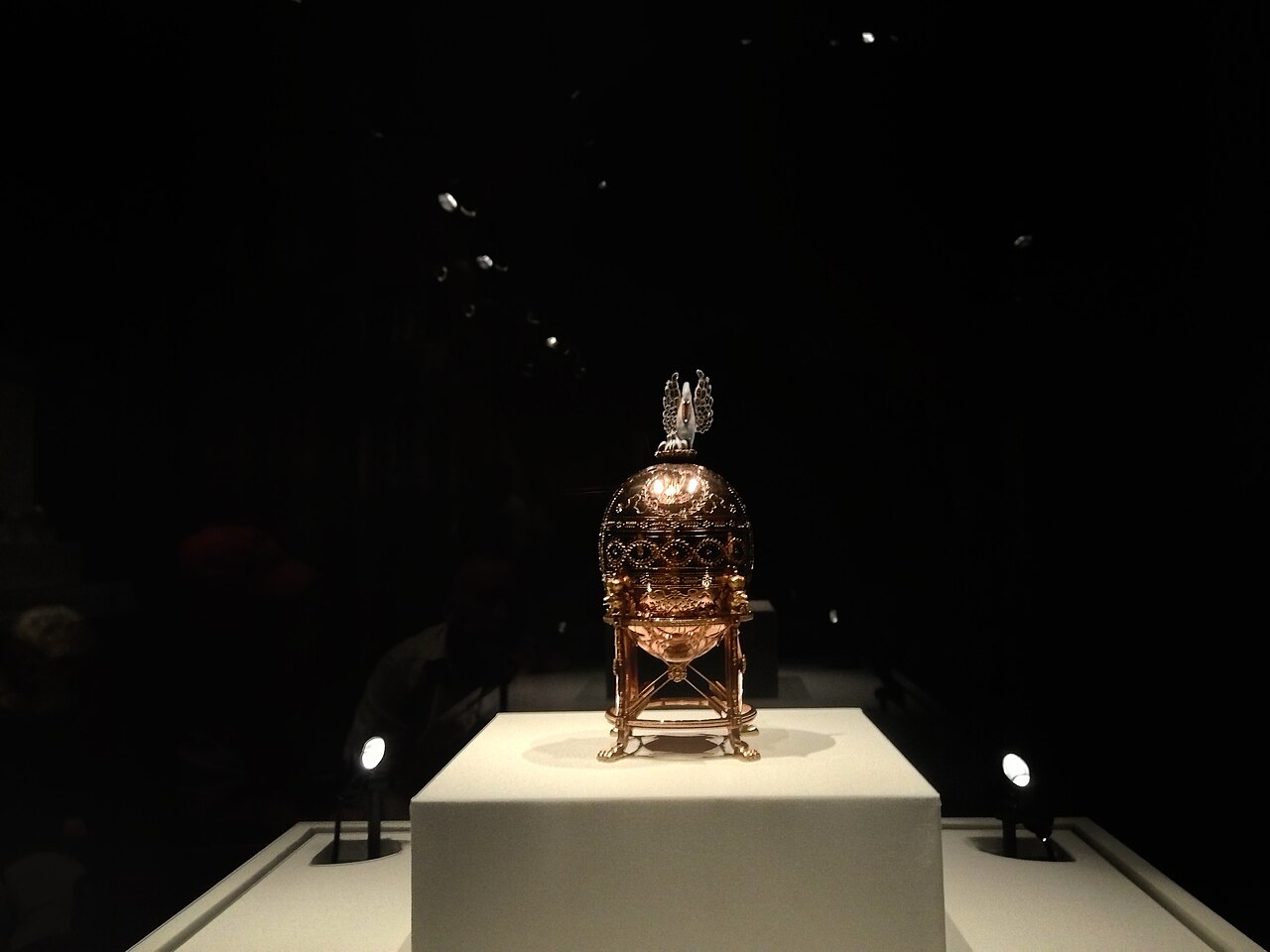 WestportWiki, CC BY-SA 3.0, Wikimedia Commons
WestportWiki, CC BY-SA 3.0, Wikimedia Commons
Pansy (1899)
The Pansy egg is one of only three eggs crafted in the Art Nouveau style. The nephrite egg is decorated with five pansies. Inside the egg is an easel that holds 11 tiny covers. By pressing a button inside the egg, the covers open up to reveal miniature paintings of the Imperial Family.
Trans-Siberian Railway (1900)
This egg is constructed from onyx, silver, gold, and quartz, and contains a miniature replica of a steam train as its surprise. Created to commemorate the famous cross-Russia railway, the outside of the Trans-Siberian egg is engraved with a map of the railway’s route, with all the major stops marked by jewels or precious stones.
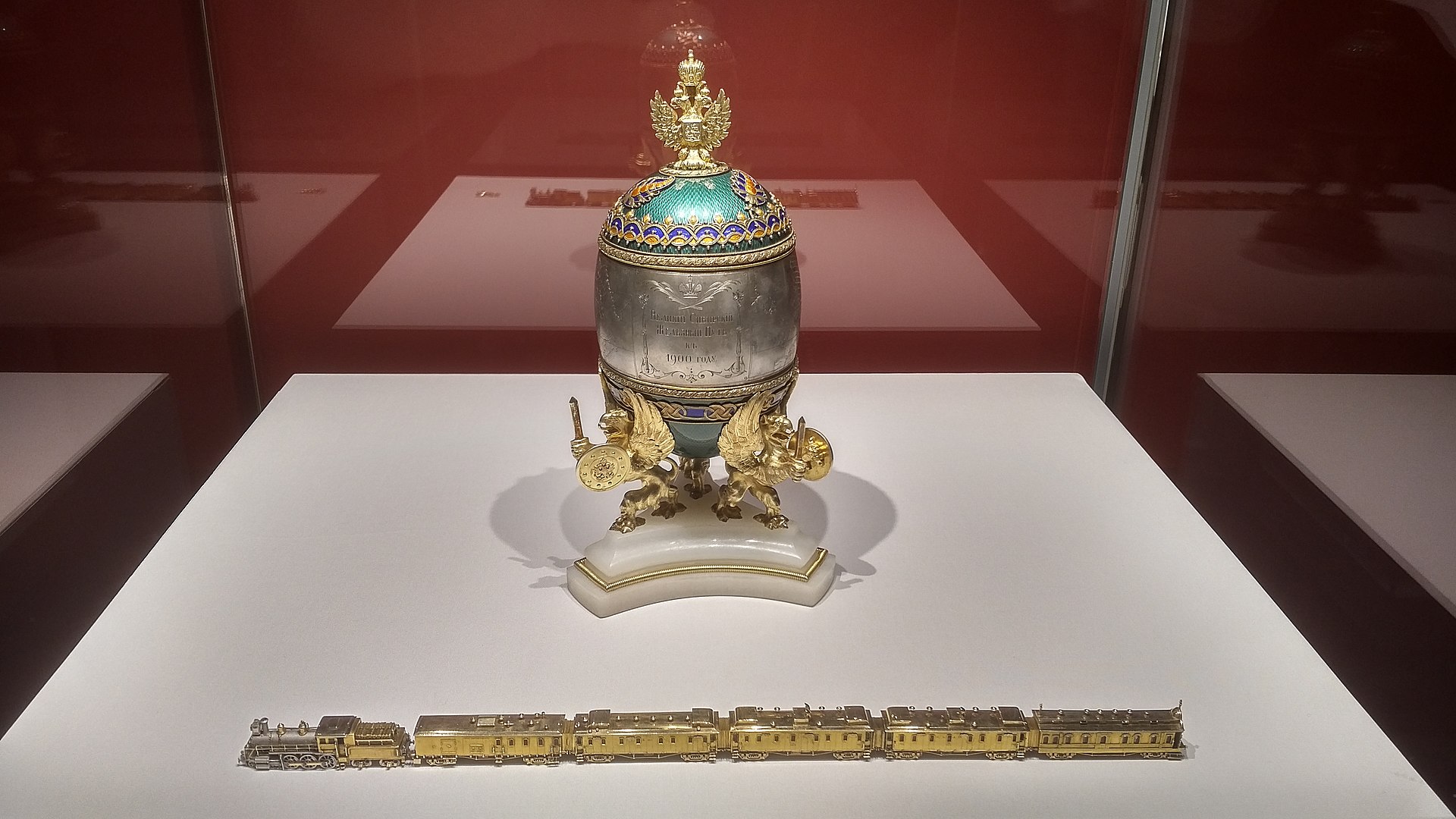 Maxim Sinelshchikov, Wikimedia Commons
Maxim Sinelshchikov, Wikimedia Commons

History's most fascinating stories and darkest secrets, delivered to your inbox daily.
Basket Of Flowers (1901)
For a while, there was some concern that this was not actually one of the Imperial eggs. There is no evidence that the Basket of Flowers, which looks like a basket of flowers, ever had a surprise inside, and there is no documentation of the craftsman who created it. In 1991, international experts agreed, however, that this was indeed one of the Imperial Fabergé eggs.
Gatchina Palace (1901)
This egg was a gift from Nicholas II to his mother, the Dowager Empress. The gold and enamel egg opens up to reveal a miniature sculpture of Gatchina Palace, from which the egg gets its name. Gatchina Palace was the Dowager Empress’s residence, located outside of the city of St Petersburg.
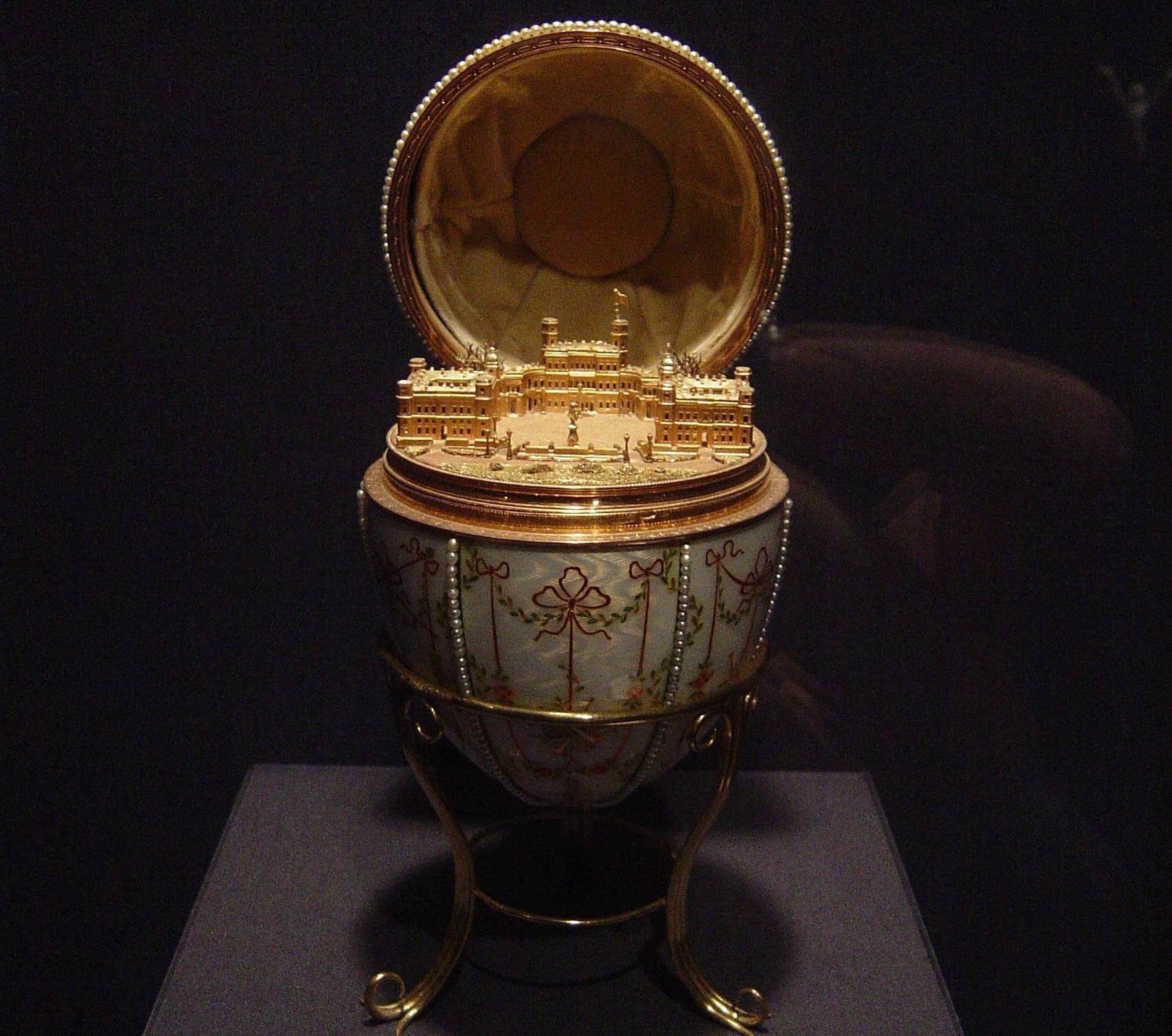 Walters Art Museum, Wikimedia Commons
Walters Art Museum, Wikimedia Commons
Clover Leaf (1902)
The Clover Leaf egg used a process to create transparent enamel that was very new at the time. Due to some inconsistencies in the process, the Clover Leaf is considered too fragile to travel and resides in a museum in Moscow. The lost surprise is said to have been a diamond-studded four-leaf clover with a portrait of each of the Tsar’s daughters on the leaves.
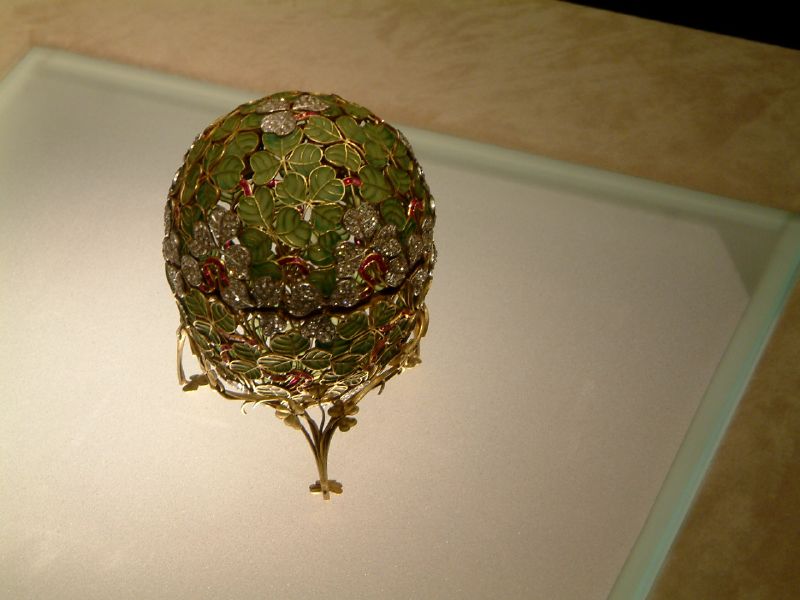 greenacre8, CC BY 2.0, Wikimedia Commons
greenacre8, CC BY 2.0, Wikimedia Commons
Peter The Great (1903)
1903 marked the 200th anniversary of the founding of St Petersburg, so the Peter the Great Fabergé egg was created to celebrate this momentous occasion. The red, green, and yellow gold egg opens to reveal a miniature model of Peter the Great’s monument, while the outside features paintings of Peter, Nicholas II, and the Winter Palace.
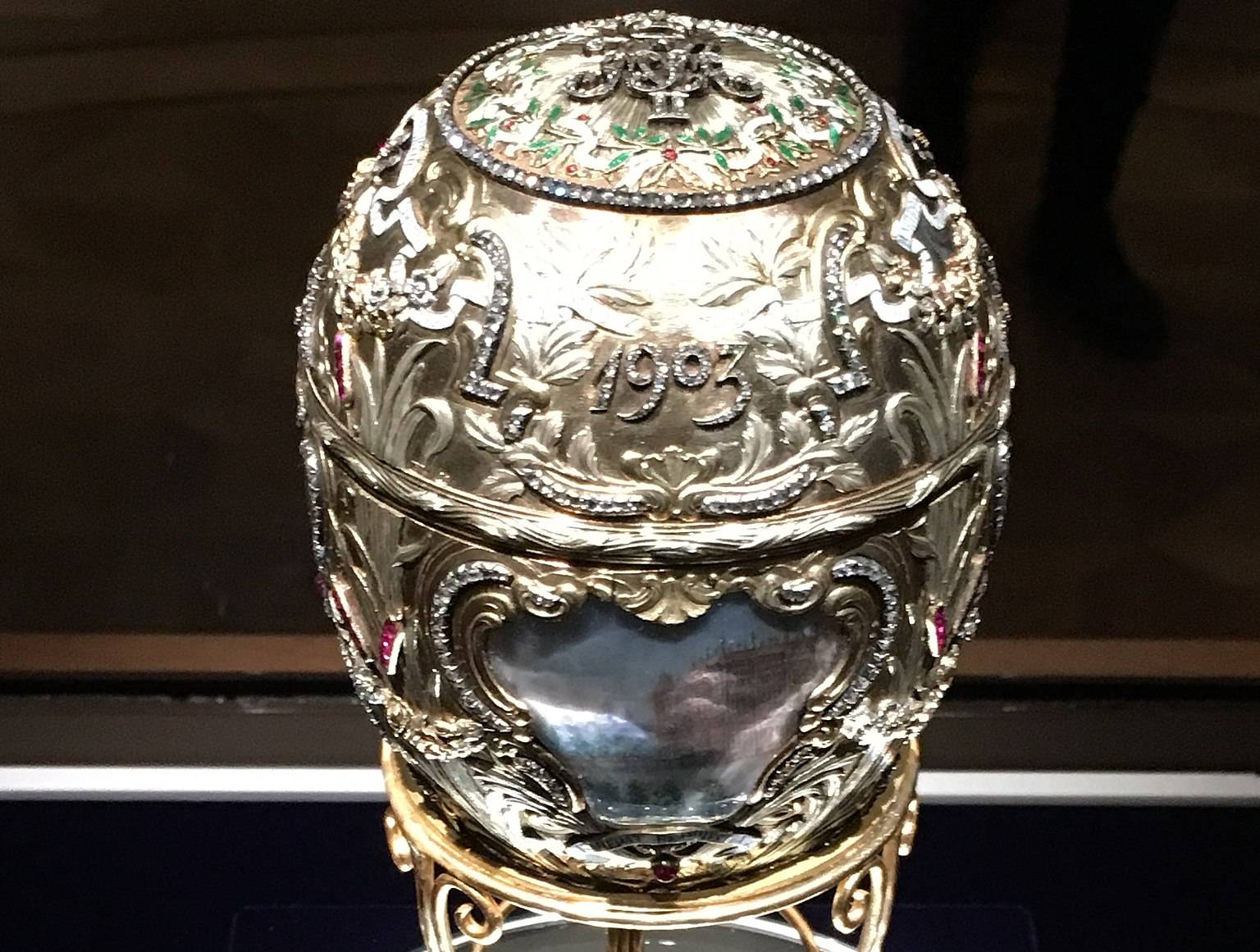 Hemant Bedekar, CC BY 2.0, Wikimedia Commons
Hemant Bedekar, CC BY 2.0, Wikimedia Commons
Moscow Kremlin (1906)
At 14.2 inches, the Moscow Kremlin is the largest of the Imperial eggs. Inspired by a famous cathedral, the top of the egg can be lifted off to reveal a highly detailed miniature model of the interior of the building. The surprise in the egg is contained in the base, which is a music box that plays two traditional Easter hymns when it is wound.
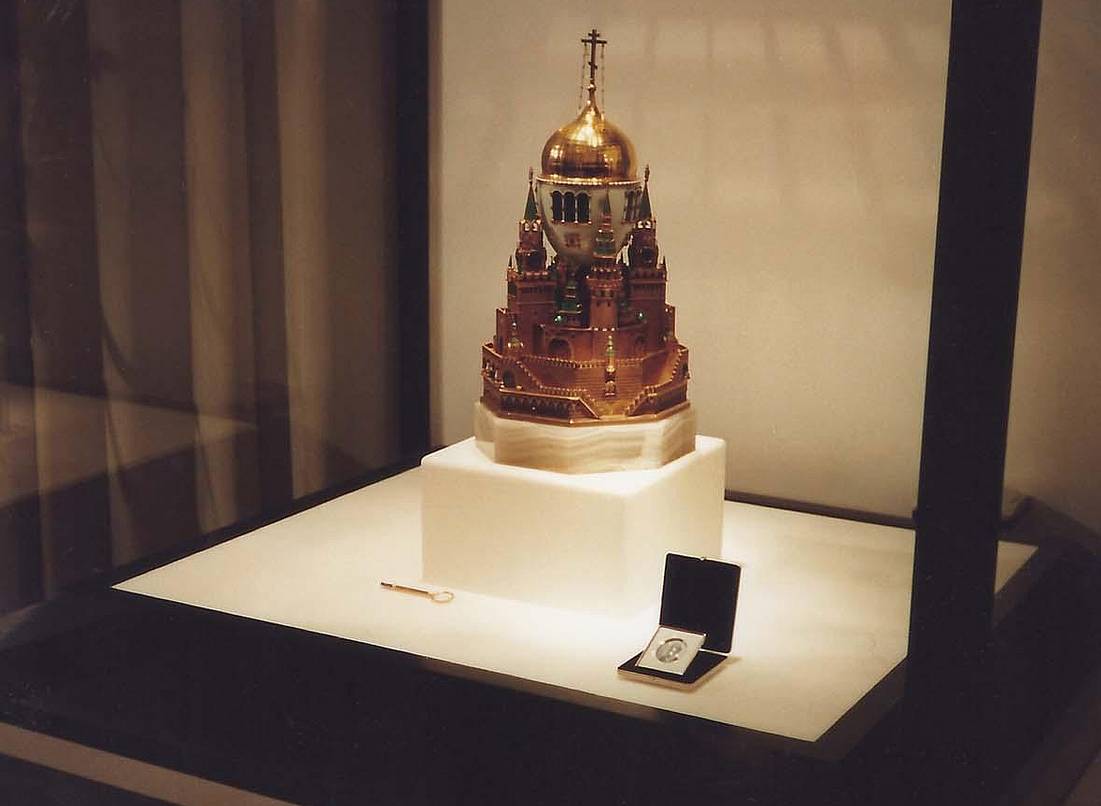 alexei.maximov, CC BY-SA 2.0, Wikimedia Commons
alexei.maximov, CC BY-SA 2.0, Wikimedia Commons
Swan (1906)
This egg is constructed from mauve enamel with a gold trim around the outside. It was presented to the Dowager Empress as a remembrance of her 40th wedding anniversary. The Swan egg gets its name from the surprise inside: a miniature swan automaton that moves its neck and wings when a tiny gear on the bird is wound.

History's most fascinating stories and darkest secrets, delivered to your inbox daily.
Rose Trellis (1907)
This gold, green, and pink enamel egg is covered with diamonds and, when opened, has a satin lining. The surprise inside is a diamond necklace and a portrait, though the portrait has long since been lost. The only evidence of its presence is an impression on the lining in the Rose Trellis where the painting once sat.
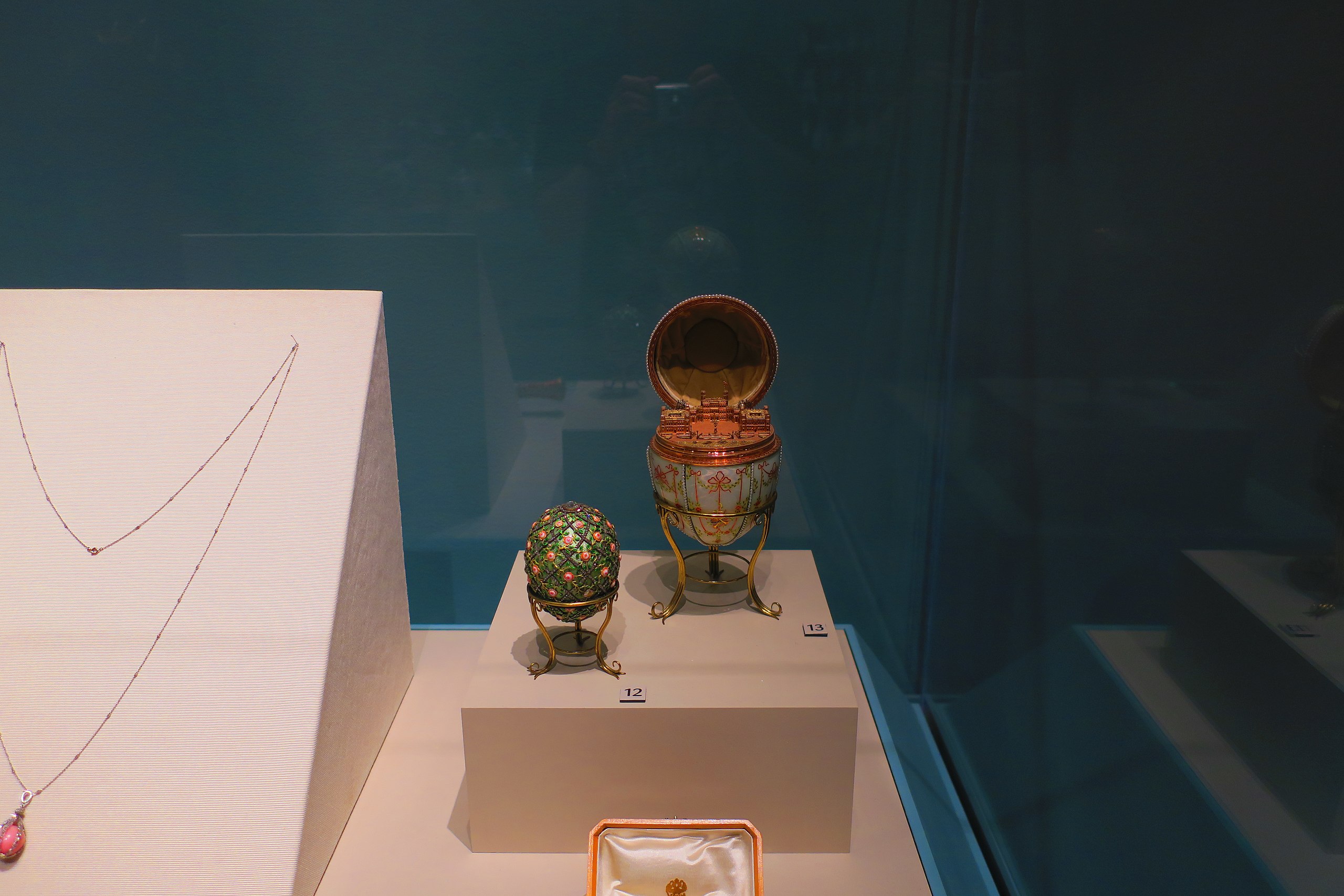 Chris Dignes, Wikimedia Commons
Chris Dignes, Wikimedia Commons
Cradle With Garlands (1907)
This jewel-encrusted egg, made of gold and translucent enamel, is one of the Imperial eggs that are currently in a private collection. The surprise in the egg is currently missing, but an invoice from the Fabergé company for the Cradle With Garlands notes that it would have been a miniature of the Imperial children.
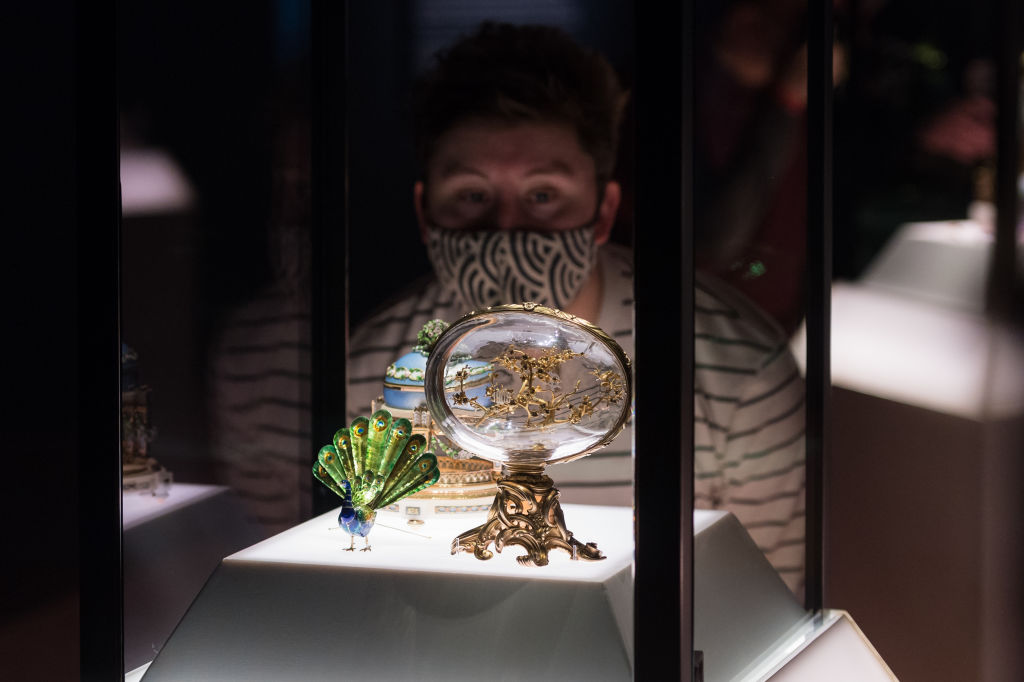 Wiktor Szymanowicz, Getty Images
Wiktor Szymanowicz, Getty Images
Alexander Palace (1908)
The outside of this egg, along with the gold, enamel, and jewels, features five tiny portraits of the five children of Nicholas II and Alexandra. The surprise inside the Alexander Palace egg is a tiny model of Alexander Palace, the Russian Imperial family’s favorite residence, as well as the palace’s adjoining gardens.
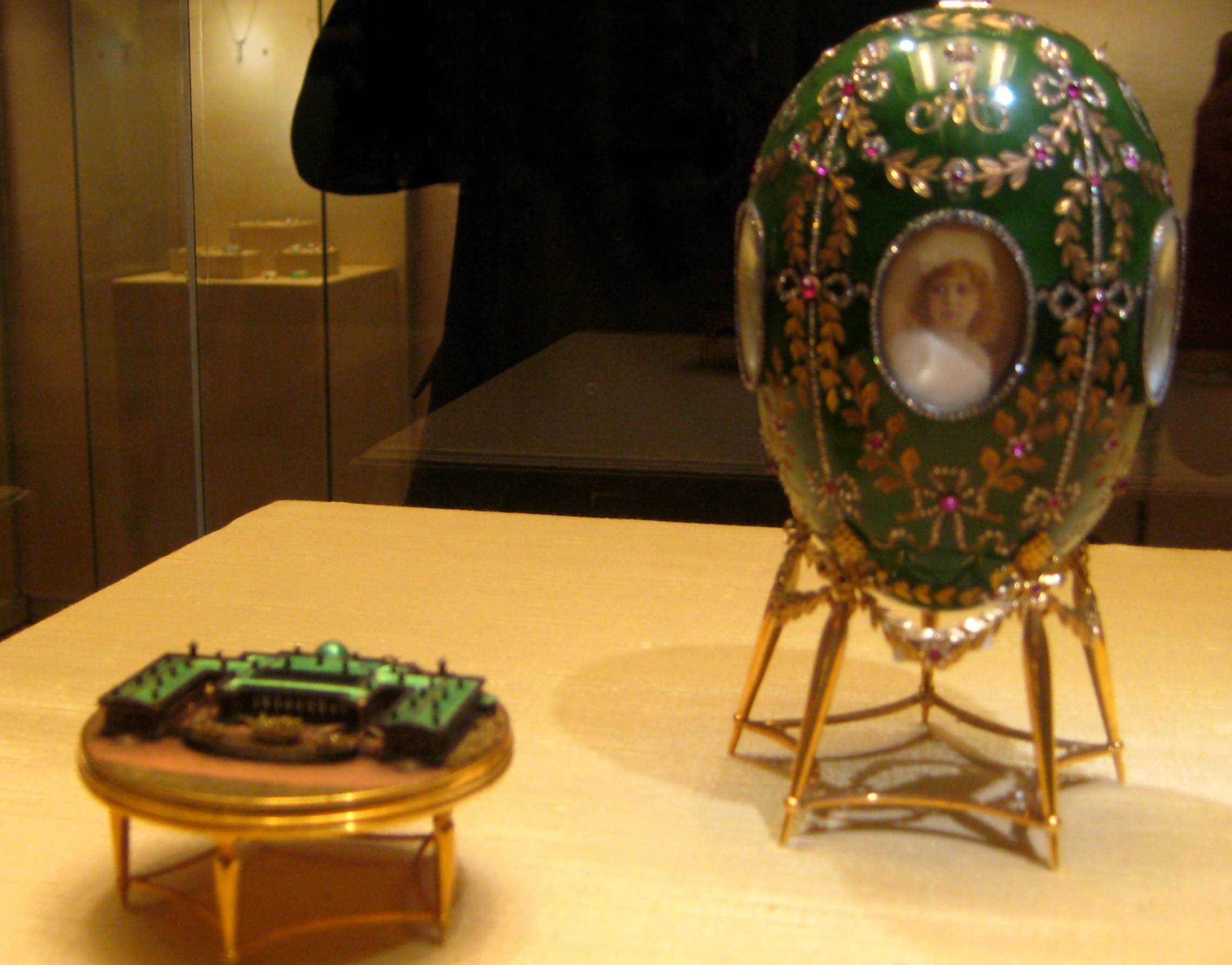 shakko, CC BY-SA 3.0, Wikimedia Commons
shakko, CC BY-SA 3.0, Wikimedia Commons
Peacock (1908)
By contrast to the other eggs, the Peacock is relatively simple. The transparent egg is made from rock crystal and silver wire and contains an amazing surprise. Inside is a small gold and enamel peacock. The peacock can be removed and wound up, and will then walk about moving its head and spreading its tail.
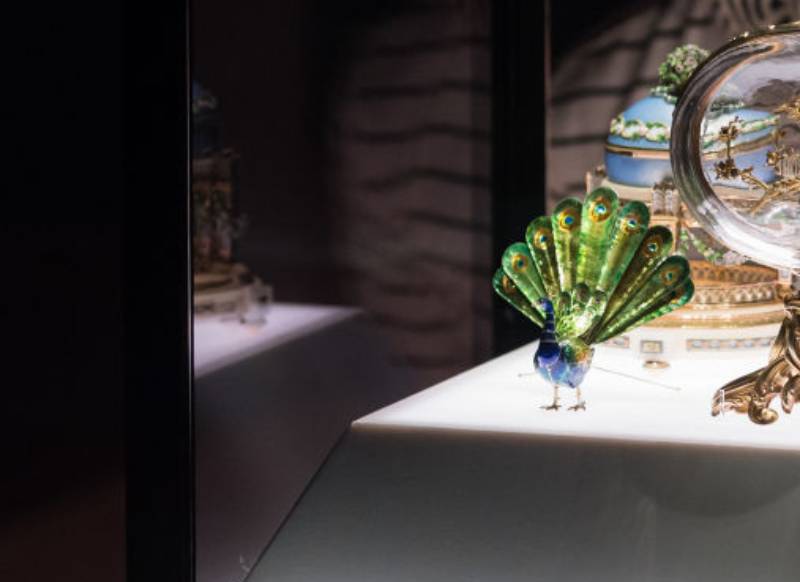 Wiktor Szymanowicz, Getty Images
Wiktor Szymanowicz, Getty Images
Standart Yacht (1909)
No, it’s not a typo! The surprise inside this egg is a replica of the Imperial yacht, known as the Standart Yacht. The egg is named for this yacht. The transparent egg is decorated with lapis lazuli eagles and dolphins. The yacht was a favored vacation for the royal family.
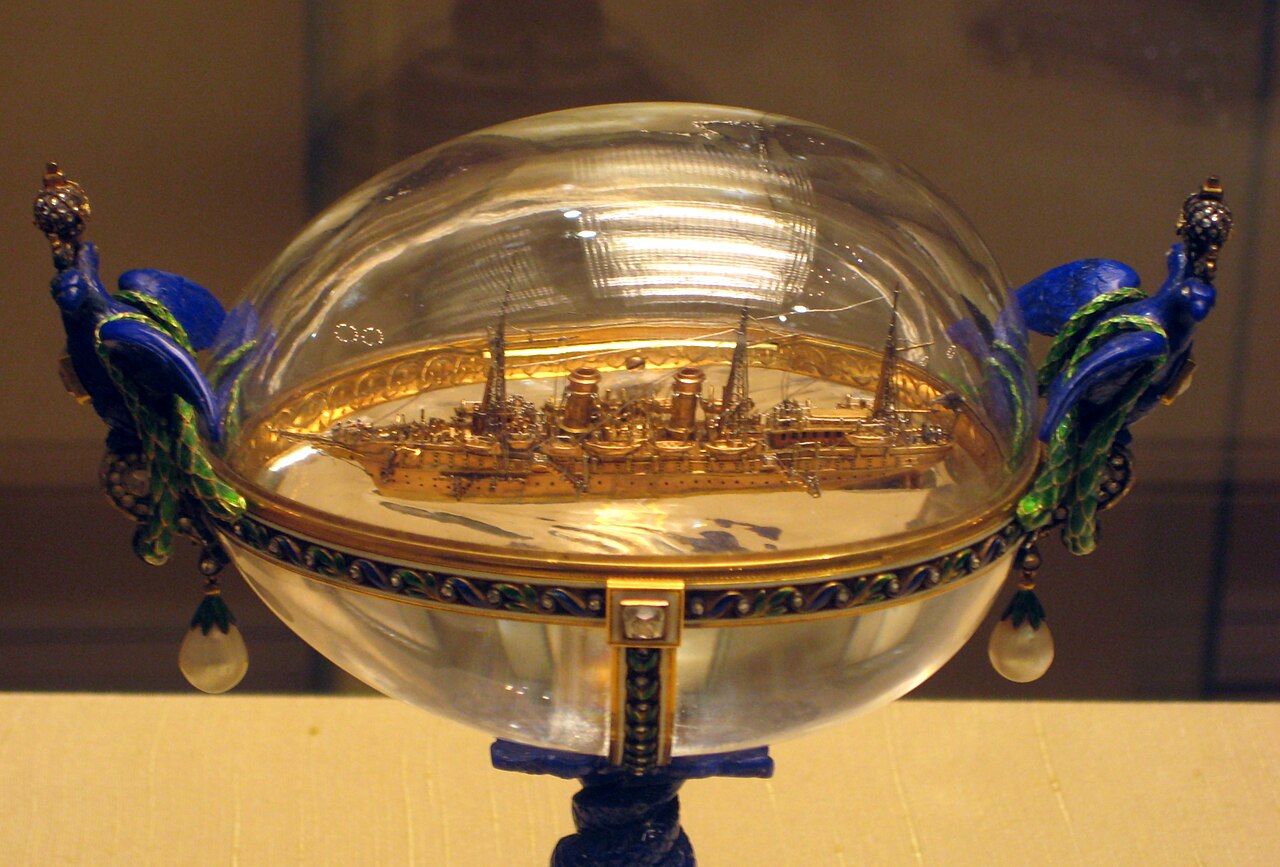 shakko, CC BY-SA 3.0, Wikimedia Commons
shakko, CC BY-SA 3.0, Wikimedia Commons
Alexander III Equestrian (1910)
This rock-quartz crystal egg was a gift to the Dowager Empress and features as a surprise a small sculpture of Alexander III on horseback. Like many of the Imperial Fabergé eggs, this one features a diamond cut with the date. The Alexander III Equestrian egg is currently held at the Kremlin Armoury Museum in Moscow.
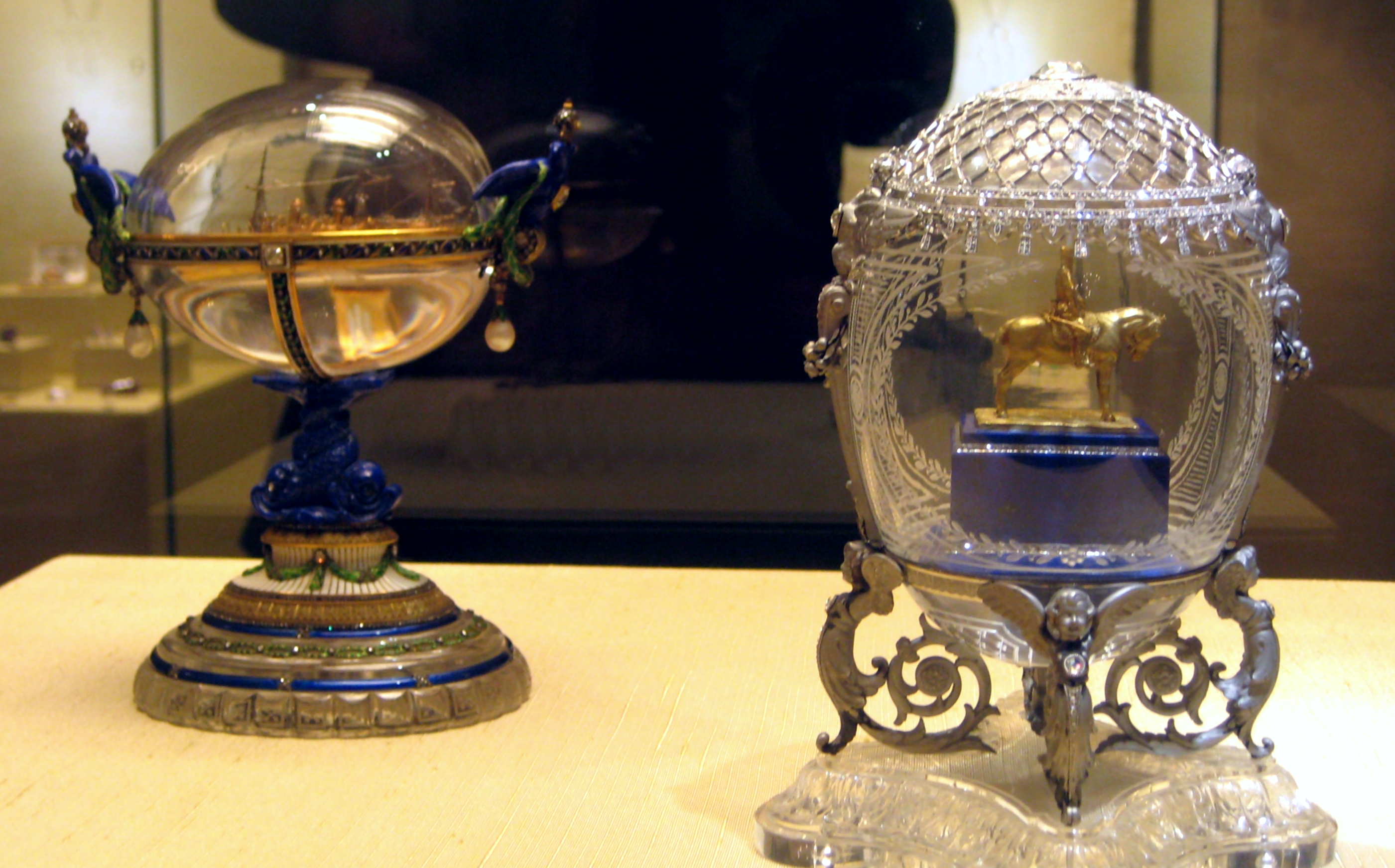 shakko, CC BY-SA 3.0, Wikimedia Commons
shakko, CC BY-SA 3.0, Wikimedia Commons

History's most fascinating stories and darkest secrets, delivered to your inbox daily.
Fifteenth Anniversary (1911)
Each of the 18 panels on the outside of this egg features a miniature painting, either portraits of family members or pictures of important places and events. The Fifteen Anniversary egg commemorates the fifteenth anniversary of Tsar Nicholas’s coronation. It is one of the only Russian Imperial eggs that seems to never have included a surprise inside.
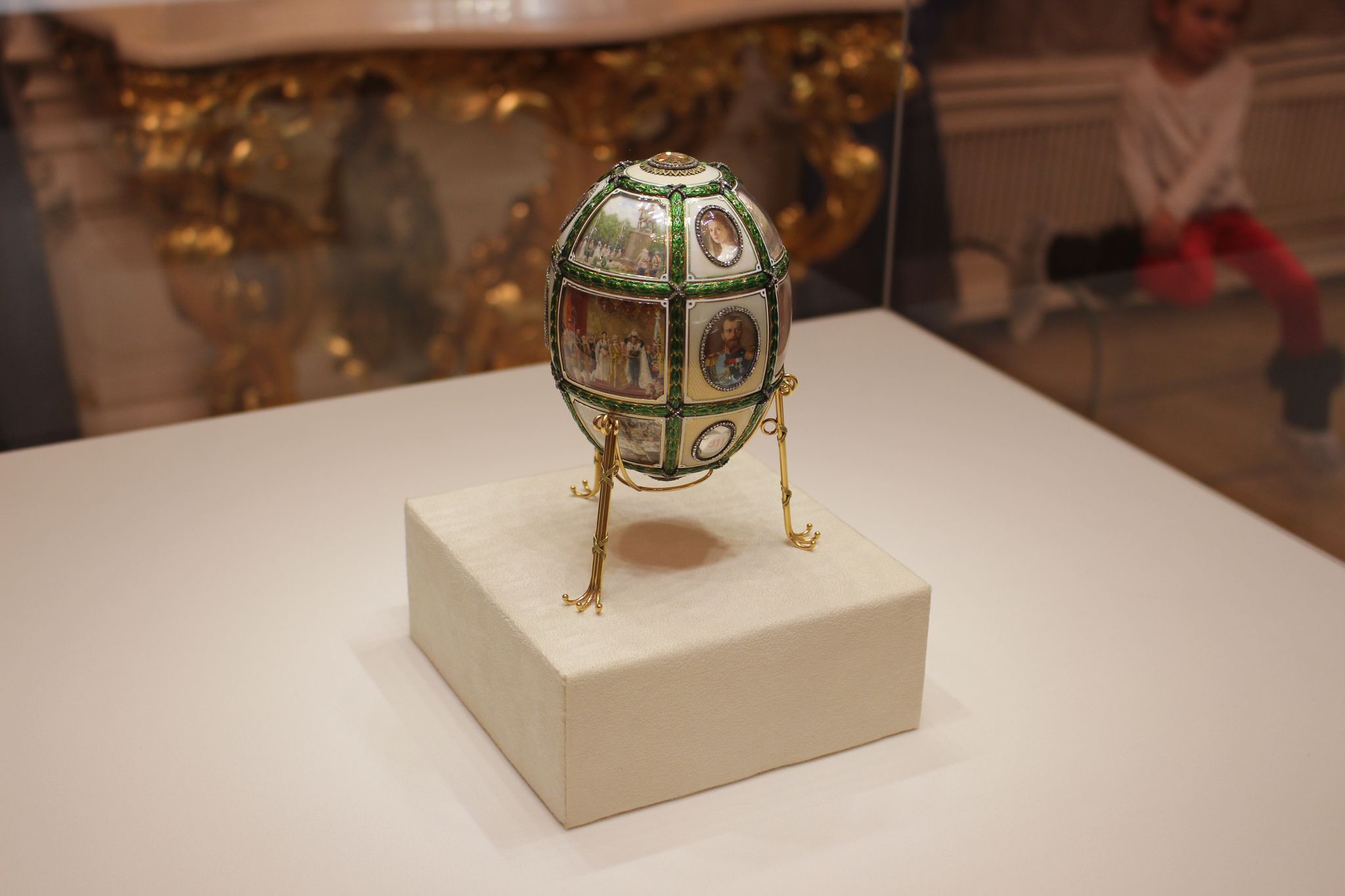 Guy Fawkes, CC BY-SA 2.0, Wikimedia Commons
Guy Fawkes, CC BY-SA 2.0, Wikimedia Commons
Bay Tree (1911)
This egg resembles a tree and is sometimes called the Orange Tree egg. The Bay Tree contains an ingenious surprise. By twisting one of the jeweled fruits on the outside, a mechanism is engaged that causes a tiny songbird to emerge from the tree, flapping its wings and singing a song.
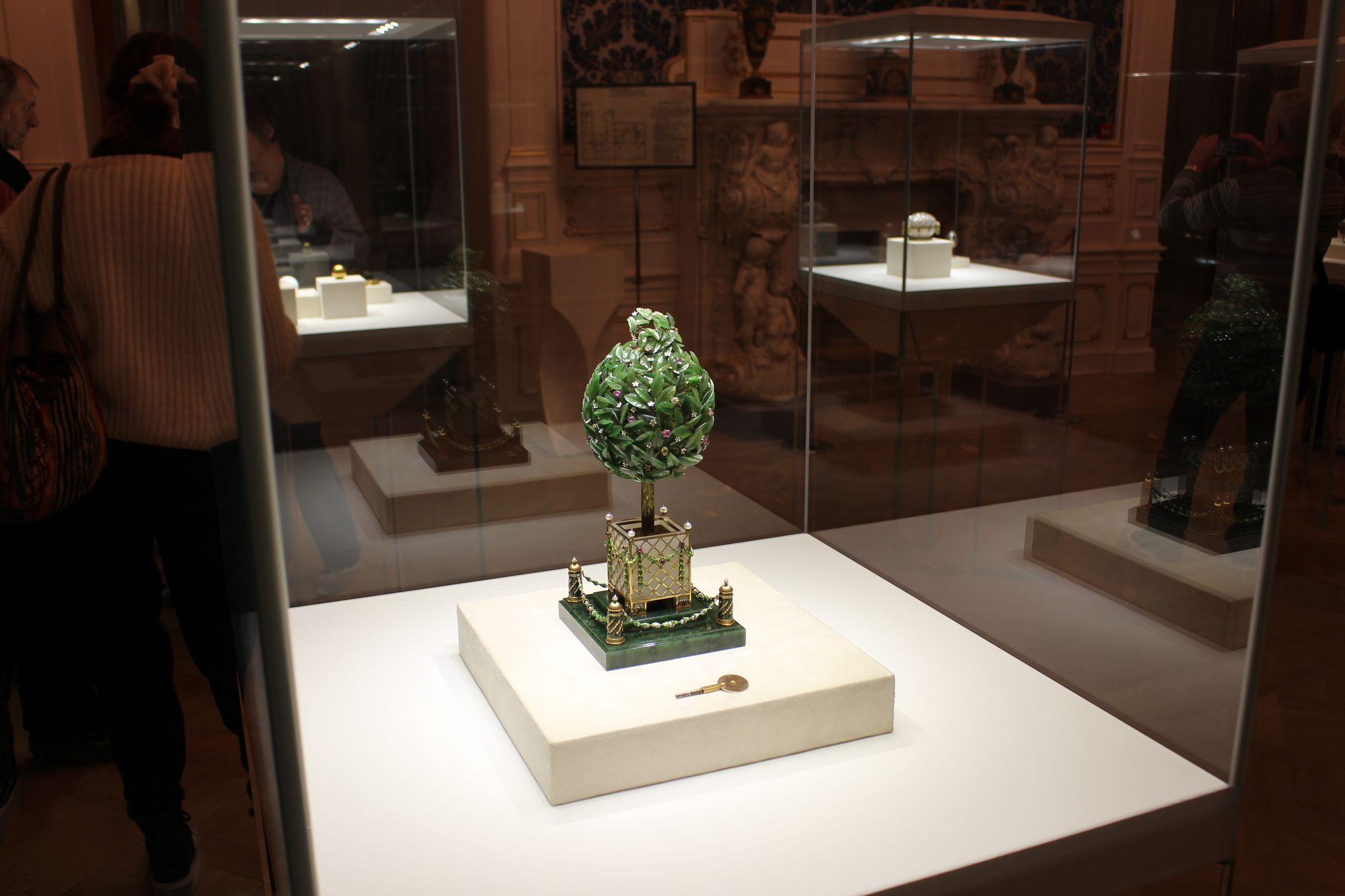 Guy Fawkes, CC BY-SA 2.0, Wikimedia Commons
Guy Fawkes, CC BY-SA 2.0, Wikimedia Commons
Tsarevich (1912)
This lapis lazuli-based egg was made as a tribute to Tsarevich Alexi, the only son of Nicholas II and Alexandra. Alexi was a hemophiliac and was not expected to live for very long. When his health improved, the Fabergé company, who were aware of his condition, made the Tsarevich egg as a tribute to the young heir.
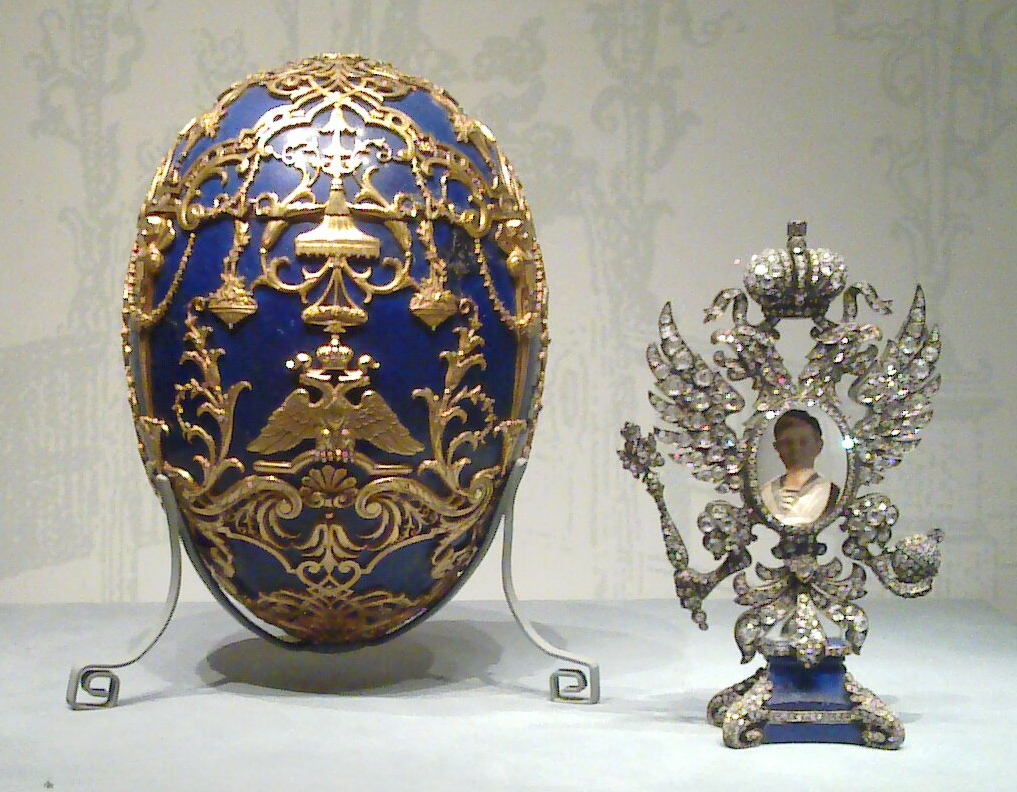 diaper, CC BY 2.0, Wikimedia Commons
diaper, CC BY 2.0, Wikimedia Commons
Napoleonic (1912)
This yellow gold and emerald egg was designed to commemorate the 100-year anniversary of the Battle of Borodino, part of Napoleon Bonaparte’s campaign to invade Russia in 1812. The surprise inside the Napoleonic is a series of miniature pictures of military regiments. The screen is made out of translucent emeralds and white enamel.
 Josh B, CC BY-SA 2.0, Wikimedia Commons
Josh B, CC BY-SA 2.0, Wikimedia Commons
Romanov Tercentenary (1913)
This egg was fashioned to celebrate 300 years of Romanov family rule in Russia. The Tsar and Tsarina retraced the journey across the country of Michael Romanov to the throne in 1613, accompanied by celebrations wherever they went. The surprise inside the Romanov Tercentenary egg is a globe that depicts Russian territory in 1613 and in 1913.
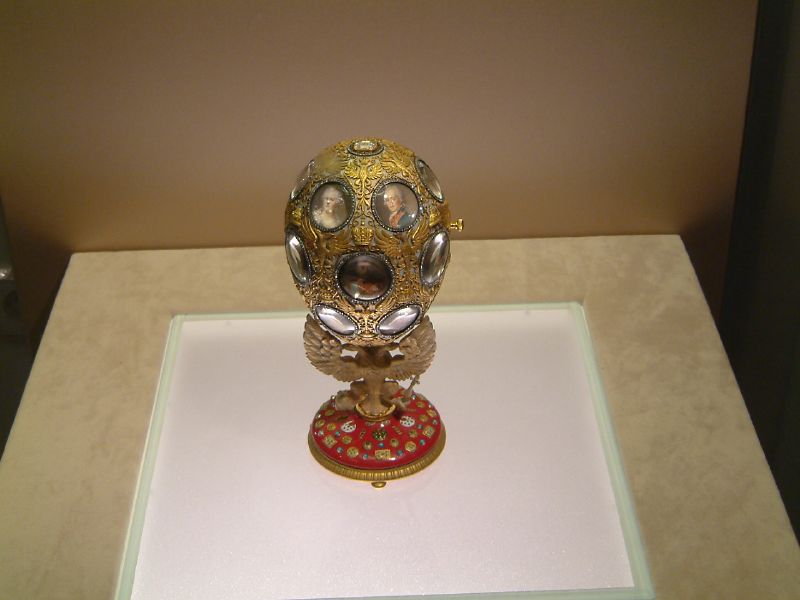 greenacre8, CC BY 2.0, Wikimedia Commons
greenacre8, CC BY 2.0, Wikimedia Commons
Winter (1913)
The Winter egg of 1913 is the most expensive of the Imperial Fabergé eggs, costing Nicholas II 24,700 rubles. The exterior of the egg is studded with 1,660 diamonds, while the surprise, a miniature flower basket, features 1,378 diamonds. In 2002, the egg sold for US$9.6 million at auction. The Winter egg is also the only Fabergé Imperial egg to have been designed by a woman, Alma Pihl.
 Wiktor Szymanowicz, Getty Images
Wiktor Szymanowicz, Getty Images

History's most fascinating stories and darkest secrets, delivered to your inbox daily.
Mosaic (1914)
The design of the Mosaic egg was inspired by needlework fire screens that were popular in the sitting rooms of Russian aristocrats of the time. The surprise inside resembles a cameo brooch and features profiles of the Romanov children on one side and a basket of flowers on the other.
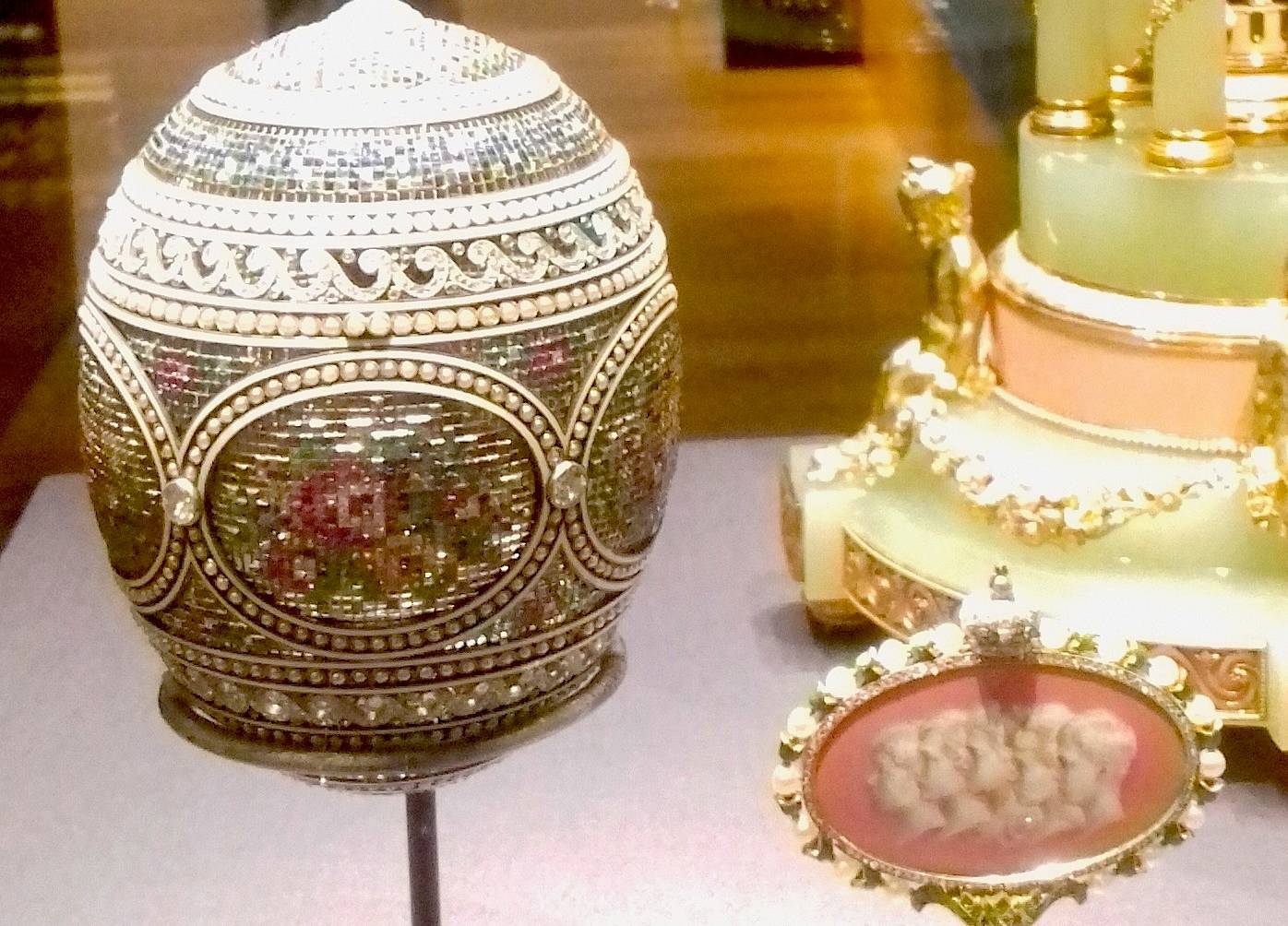 Jafd88, CC BY-SA 4.0, Wikimedia Commons
Jafd88, CC BY-SA 4.0, Wikimedia Commons
Catherine The Great (1914)
The Catherine the Great egg is also known as the Pink Cameo or Grisaille Egg. The outer shell is a series of allegorical scenes on pink enamel, while the surprise is a wind-up automaton of Catherine the Great being carried on a sedan chair. The surprise walks when wound and placed on a flat surface.
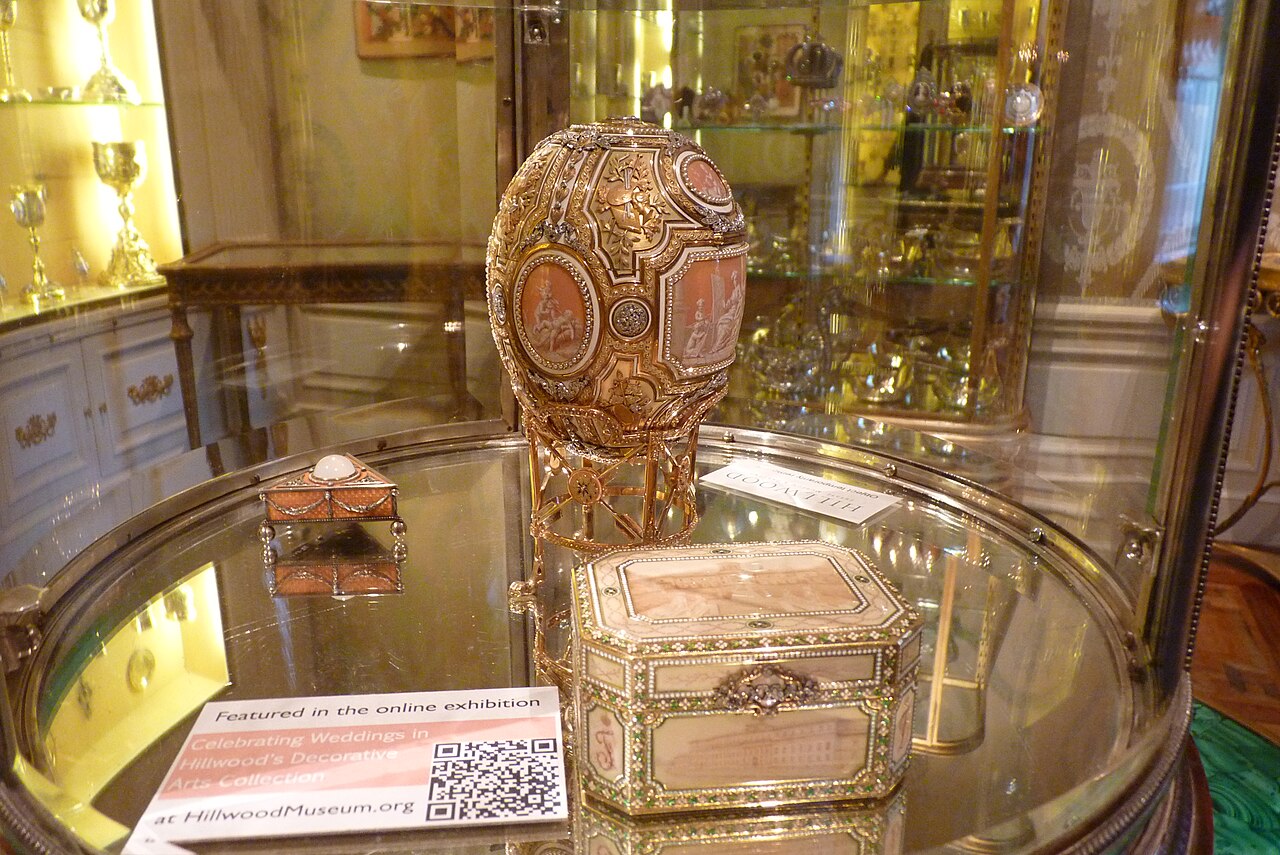 ctj71081, CC BY-SA 2.0, Wikimedia Commons
ctj71081, CC BY-SA 2.0, Wikimedia Commons
Red Cross With Triptych (1915)
Cast in silver, gold, white, and red enamel, the Red Cross with Triptych opens vertically to reveal three paintings within: The Harrowing of Hell, Saint Olga, founder of Russian Christianity, and Saint Tatiana, a martyr. Olga and Tatiana were the names of two of the Tsar’s daughters, and they were featured on the outside of the egg in their Red Cross uniforms.
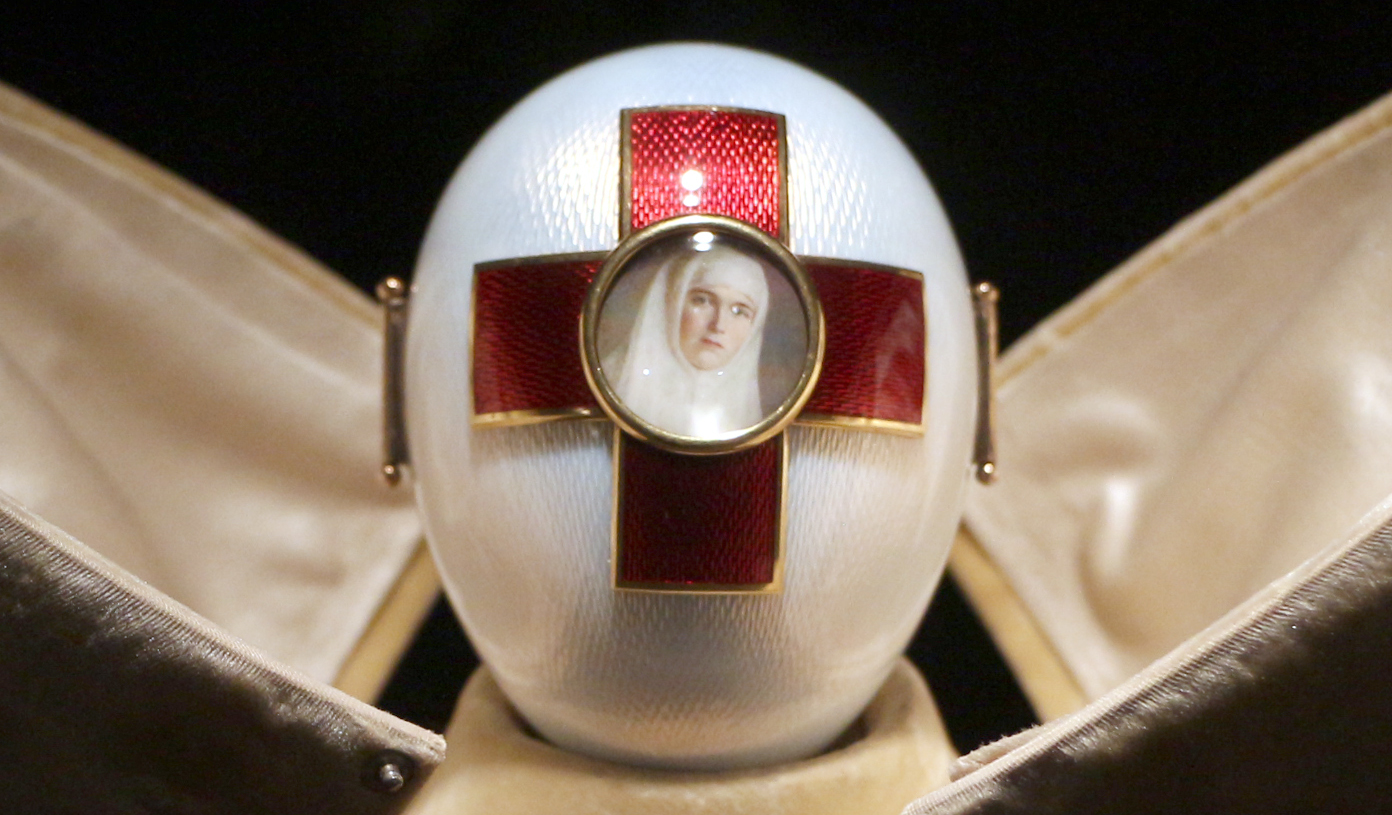 Sailko, CC BY 3.0, Wikimedia Commons
Sailko, CC BY 3.0, Wikimedia Commons
Red Cross With Imperial Portraits (1915)
The Red Cross with Imperial Portraits is a tribute to the service of the Romanov women in the Red Cross during various conflicts in Russia’s history. The surprise inside is a series of five portraits on a folding screen that depicts the women in their Red Cross uniforms. The Dowager Empress was still head of the Russian International Red Cross when Nicholas presented her with this gift.
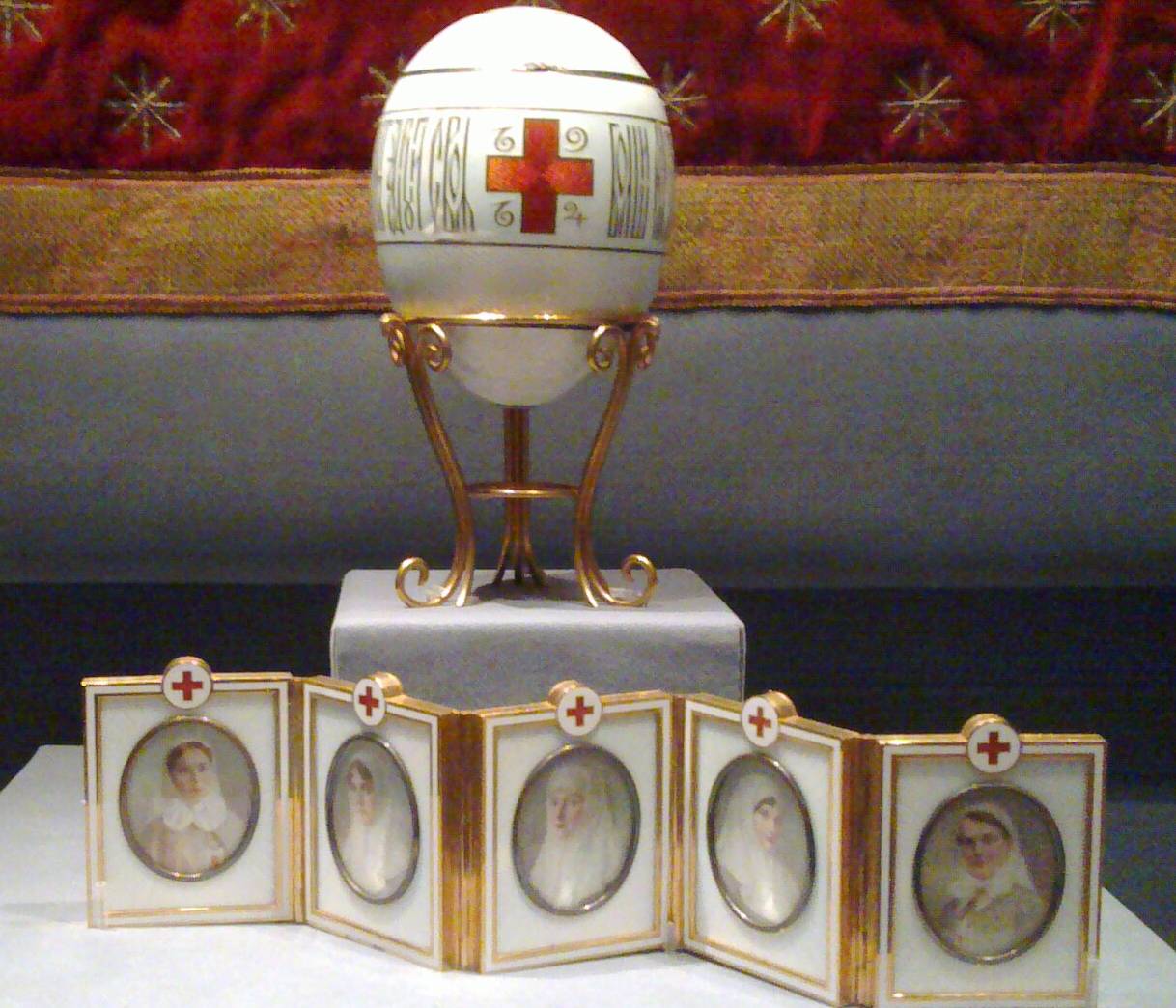 House of Fabergé, CC BY 2.0, Wikimedia Commons
House of Fabergé, CC BY 2.0, Wikimedia Commons
Steel Military (1916)
Considered one of the least impressive eggs, the Steel Military was created from gold and steel. The steel came from the Putilovskii Steel Plant, renowned for its high-quality metal. The surprise inside depicts Tsar Nicholas and his eldest son at the front in WWI, where they were when this egg and the next one were delivered, respectively, to the Tsarina and the Dowager Empress.
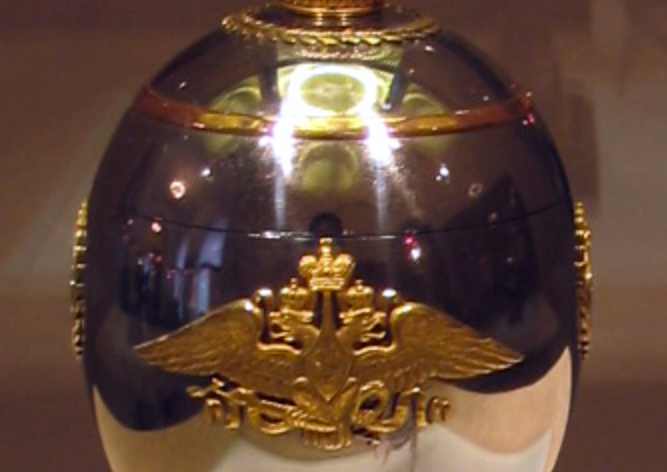 madoa, CC BY-SA 2.0, Wikimedia Commons
madoa, CC BY-SA 2.0, Wikimedia Commons
Order Of St George (1916)
When the Russian Revolution occurred in 1917, the Dowager Empress fled Russia for her native Denmark. The Order of St George egg was the only Imperial egg she took with her when escaping the country. The egg’s surprises are concealed behind two medallions on the outside, and are depictions of Tsar Nicholas II and his eldest son, Grand Duke Alexei Nikolaievich.
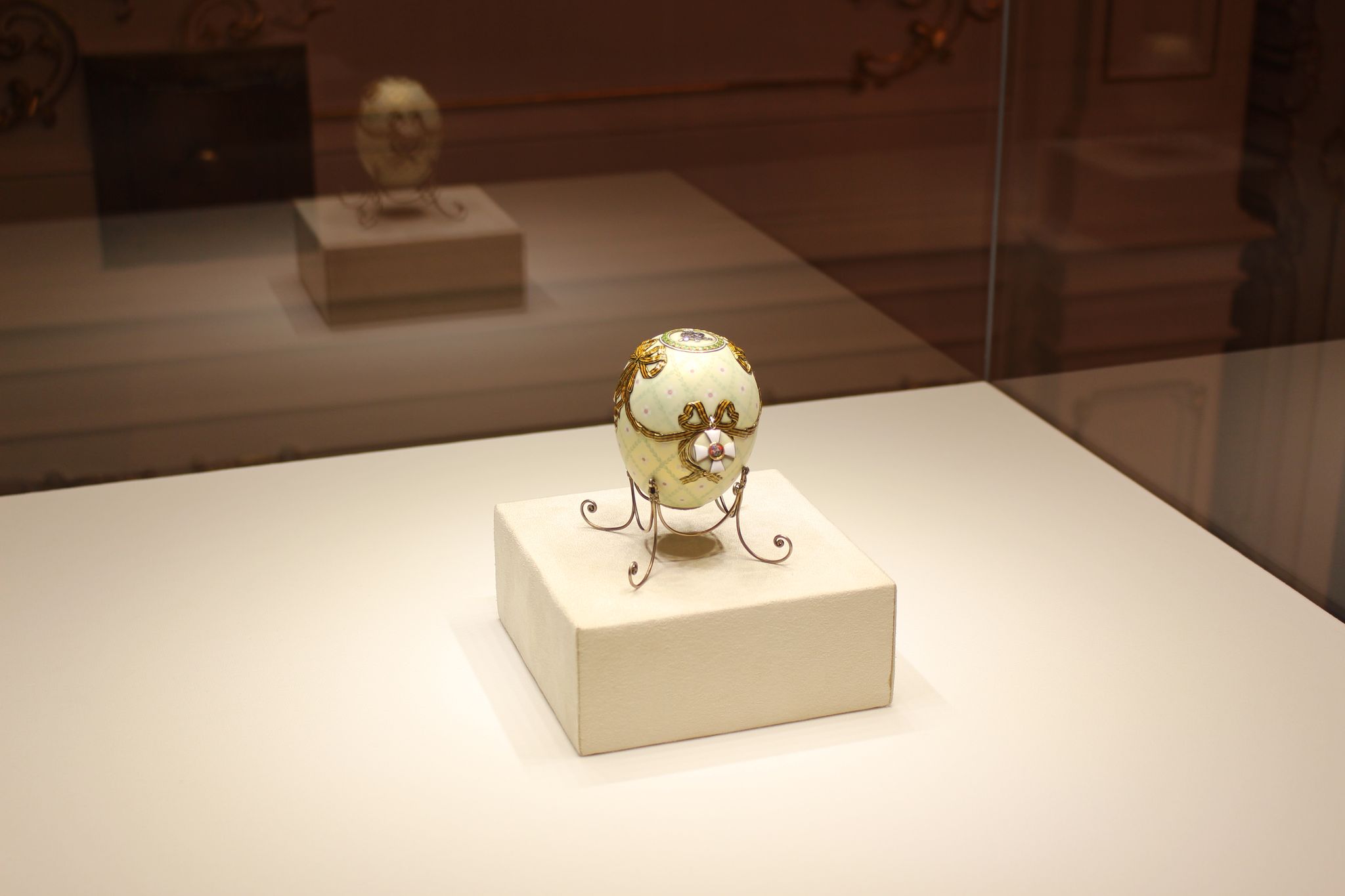 Guy Fawkes, CC BY-SA 2.0, Wikimedia Commons
Guy Fawkes, CC BY-SA 2.0, Wikimedia Commons

History's most fascinating stories and darkest secrets, delivered to your inbox daily.
The Clocks
One interesting subset of the Fabergé eggs is a group consisting of working clocks. Some, like the Blue Serpent or the Bouquet of Lilies, have a numbered band that rotates around the outside of the egg, telling the hour. The Cockeral and the Colonnade are other examples of clock-based eggs. The last egg made, the unfinished Constellation of 1917, was also intended to be a clock.
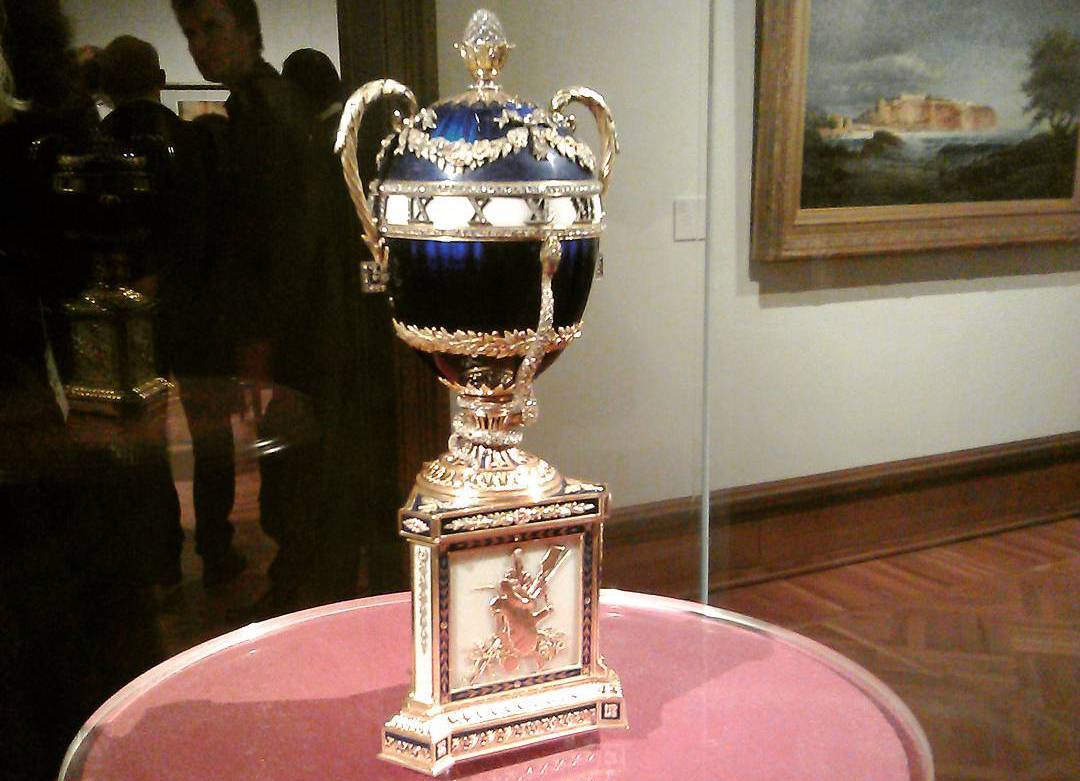 shakko, CC BY-SA 4.0, Wikimedia Commons
shakko, CC BY-SA 4.0, Wikimedia Commons
The “Fauxbergés”
As interest and notoriety about the Fabergé Eggs spread far and wide, there were attempts to cash in on their fame from lesser workshops. These eggs are considered “Fauxbergés”, copies and pastiches but not products of the Fabergé craftsmen. They include the “Empire Nephrite” and the “Karelian Birch” eggs.
 Academicien, CC BY-SA 4.0, Wikimedia Commons
Academicien, CC BY-SA 4.0, Wikimedia Commons
The Lost Eggs
In 2015, one of the lost Imperial Fabergé Eggs was found in the most unlikeliest of places. A scrap metal dealer found it among his family heirlooms. Not knowing the treasure he possessed, he had planned to melt it down to make a quick buck off the egg's gold. Luckily, that didn't happen—this piece of history is worth over $30 million.
Along with the eggs that are still in private and public collections, there are six eggs that have been lost. Whether destroyed or simply hidden away somewhere, waiting to be found, these eggs have not been seen for years. The lost eggs are Hen with Sapphire Pendant, Cherub with Chariot, Nécessaire, Mauve, Royal Danish, and Alexander III Commemorative.
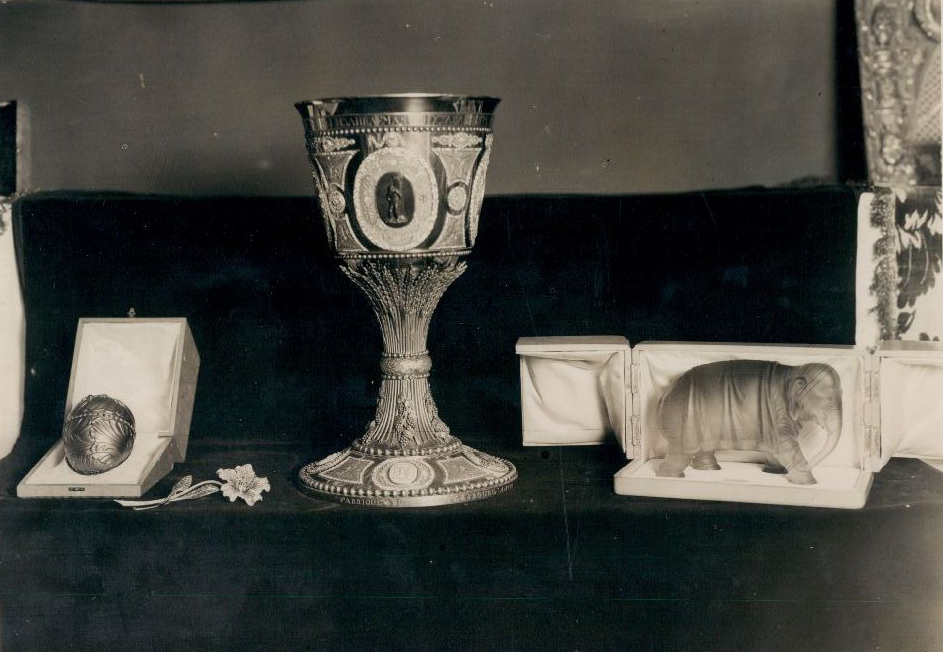 Unknown Author, Wikimedia Commons
Unknown Author, Wikimedia Commons

